



I grew up in a family of four daughters. Each of us are totally different from the other, but the thing that gets me is how much my parents encouraged our respective weirdness. I still remember being so stressed out at back-to-school shopping with my mom when I was in the 7th grade. We went to the mall and it was store after store of the same stuff. I hated all of it. I just didn’t feel like anything was ‘me’. I’m pretty sure my mom was ready to explode with my attitude, but one memory that sticks out in particular was her saying that we needed to stop by Goodwill on the way home because she had to drop off some things.
I remember walking through the clogged aisles and seeing this 1960’s Chanel-style suit jacket. It was white with pink lining, and had a rainbow-esque check pattern to it. I saw mom was talking to someone she knewso I knew I had time to shop around a little. The other sisters were outside in the car, waiting. I passed by a 1970’s Kelly green shirt in my size. I grabbed all of this stuff and walked up to my mom- who was undoubtedly surprised that I had willingly gone shopping throughout the mecca off random clothes and had found some stuff that made me happy. She didn’t bat an eyelash and was totally accepting of what I chose. Looking back, I can’t believe I felt so confident to wear these items but in my eyes they were the bees knees of fashion. I remember going home and her letting me look through her mom’s stuff. I found a vintage smocked apron with a rooster on it! My mom also let me go through her closet and I chose a late 60’s bright green sweater with embroidered mushrooms. Heaven!
It was only a few years later that I asked if I could buy yellow and orange paint, a disco ball and some glitter to “perfect” my room. My mom thought it was a great idea. She could’ve died laughing. She could’ve made fun of me. Or worse- said no. But she encouraged me to be myself. My parents never said a word when I would BLAST my radio from 7 am to 7:45 am before school started and then hours after I got home, deep in a Mariah Carey/Paula Abdul/Celine Dion concert. They always encouraged me to be, me.
The reason I’m sharing this with you is because lately I’ve been realizing what a gift it is to be yourself, and why it’s not only a gift for you, but for others. Almost every day, more and more, I am returning to the idea of being yourself on purpose. It’s something we do as little kids, and then during the formidable years seem to lose as everyone else’s idea of who we should be slowly wash away who we really are. I’m proud that I never truly lost sight of my love for all things retro, rainbows, glitter and anything magical. I’ll always look for fourleaf clovers. But the older I get, the more I realize that my reasons for not “fitting in” are the things that make me the happiest. This magazine is the very proof that when you celebrate your true self, great things can and will happen!
I hope to see you smiling and being your best self on purpose. I hope you celebrate who you are, and love that you are different- even if it doesn’t seem that way at times. I hope you enjoy this issue, the colors, the words and the love that went into it. You know I would glitter the pages if I could!
But truly, thank you for reading this magazine and supporting it. Thank you for all of the crafty people making cool stuff out of the pages! Thank you to everyone who sends it as gifts to people not in the area. Thank you for being a part of this little positive corner in the world. And special thank you to my mother- who encouraged her little girl to be herself, even if it meant her home now had it’s own unique Studio 54 and she had to wash vintage clothes carefully. It’s all proof that when you are happy and accepting of others, it helps bring out the best in yourself. May we all be this way to ourselves and others.
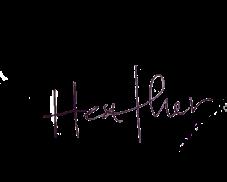
Editor-In-Chief Home&Harvest Magazine
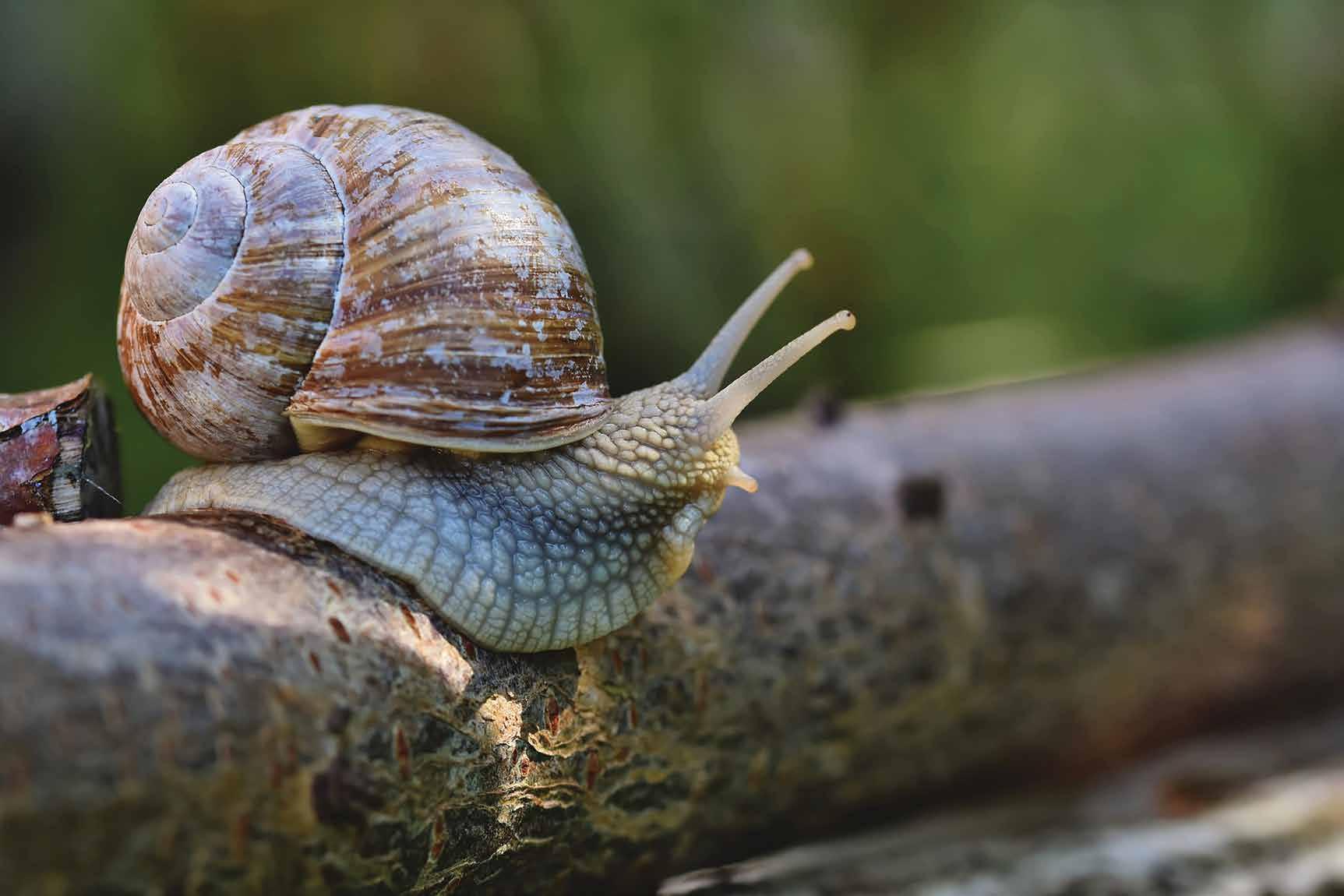

Contents 10 breath 18 space 24 all hands on deck 28 heidi’s book review 30 are you down with opg 34 thin mint cake 36 gluten-free vegetable lasagna skillet 38 raised doughnuts 40 living a low-waste lifestyle 48 home&harvest tarot 50 who is carol ryrie brink 58 people of the palouse 62 walking among giants 68 reloadin’ joe 72 tanked 76 river journal


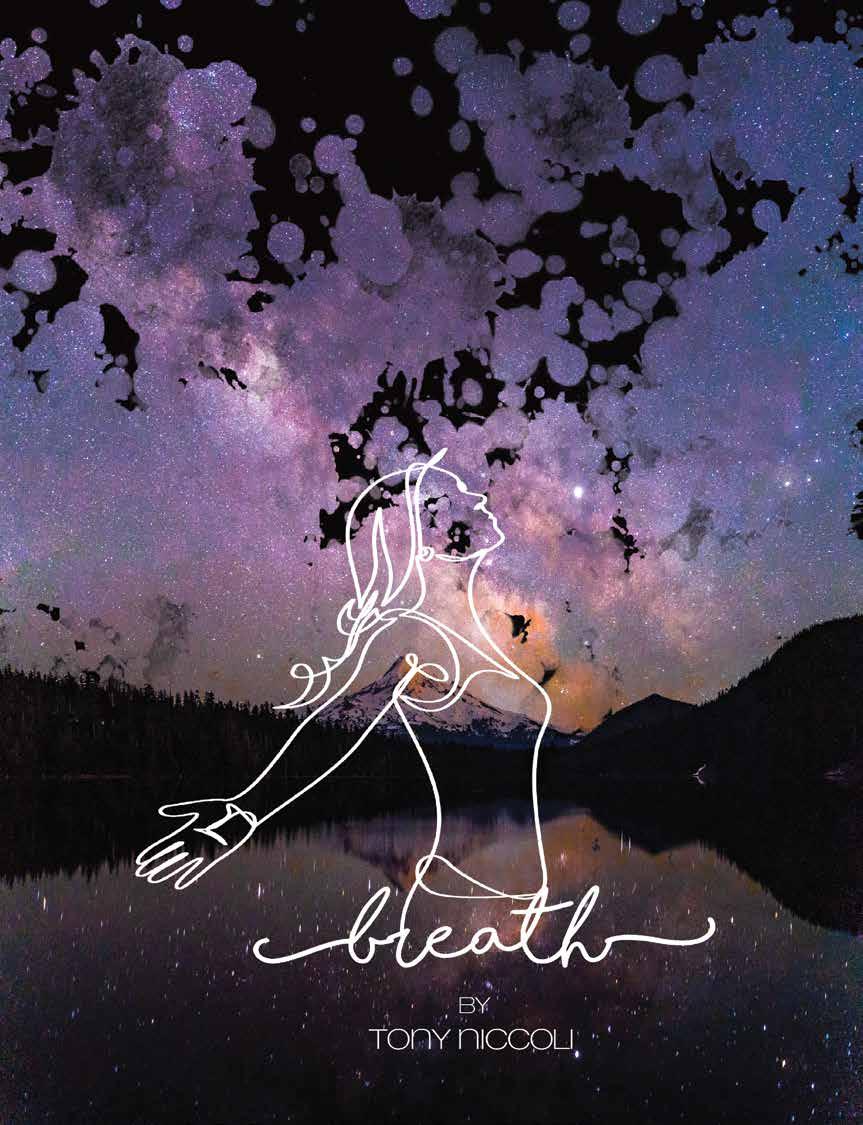
Anyone can hold me, even without their hands; yet no one can do it for long. What am I?
You take it for granted. You don’t even notice. It happens without your conscious thought. Over 20,000 times each day. It happened again as you read that last sentence. And this part will blow your mind – you’re probably doing it wrong!
Its just a simple breath.
I breathe. Like, all the time, I’m always breathing. And I know that years of repetition with bad posture, elevated stress, and lack of focus have created a habit in my breathing. You have a habit too. Your body has developed a rhythm and depth of breathing that might not be serving you. So there we have it – something as simple as breath – the thing we have all done more times in our lives than any other action, and we are all doing it wrong.
Let me explain for just a moment. I’m not blue in the face as I right this. I’m not struggling for air because of my poor habits or gasping desperately. I’m just not maximizing my health, focus, happiness, and vibration. Because every time I get lost in the thought of writing and let go of my active breathing, I return to my normal breath pattern, and breathe like I do millions of times each year. But when I clear my thoughts, take just a moment to focus, and return to conscious breathing I put my body back on a deeper and more intentional cycle. My goal in putting so much more focus on this every day is to eventually retrain my body and create a lasting effect that will follow me through life. Serving me, strengthening me, and putting me at peace with every breath – that is the ultimate goal of this reeducation of my body and mind.
Lets take a moment to look a little more closely at this miraculous cycle of respiration. For almost every breath you have ever taken in life, it was your body and subconscious mind controlling the action for you. You did absolutely nothing intentional and just had it all happen in the background as you took care of the “important” or “more interesting” things in your life. You breathe in, lungs expanding as they fill with what we hope is clean and fresh air. Your body is satisfied as it receives the much needed oxygen you had been craving, and you begin to exhale, releasing that surplus of unused oxygen and newly created carbon dioxide along with the other natural components of the air we breathe. In that moment between breaths you have given up your hold on all that extra oxygen. You have a moment without something absolutely essential to the continuation of your life. But you don’t panic as you breathe. You happily expel all that air, just knowing that there will be more available as you breathe in. We are gifted to live in environments with an abundance of fresh, breathable air. What a wonder that is.
Does it seem ridiculous to think this way? Just a few seconds spent at that bottom of a deep swimming pool as you run out of air in your lungs will quickly remind you have how terrifying it would be to spend every exhale wondering if you will ever be able to breathe in again. You kick for the top, but the delay is excruciating. Halfway up the optical change tricks you into thinking you are almost there. You long to breathe! Still a little farther to go. One final kick and your head breaks the surface. You open your mouth and take a greedy and euphoric breath, feeling that wonderful rush of oxygen to the lungs. You breathe out again – confident on the surface and no longer scared about finding your next opportunity to inhale.
Its always there until its not. We ignore it until the summer fires start and grey and toxic air drives us all back inside. But even then, the cycle of breath continues.
So how did we all get so bad at doing something so simple?
Take a deep breath now. Hold it.


Reflect on the fact that you are now in control. No more autonomous system. Exhale. And pause. Still your mind just a moment before that next breath. Inhale again, slowly through your nose. Try to hold it a little longer this time. Build a cycle that calms and centers you. Stay focused on this one moment. Exhale as slowly as you can out your mouth. In this moment you are taking responsibility for the cycle and are present in the moment. Go a little deeper this time. Slowly pull in this next breath and let your chest fully expand – take it in deeply. Hold a moment in your upright position, lungs completely engorged, diaphragm down. Hold it. Slowly release and pause in the exhaled position. Delay that next breath just a moment longer.
Okay, you can go back to autopilot now. Within the next few sentences you will have forgotten your conscious and active breath and your body will be once again in control. That’s fine, we certainly don’t have the time to micromanage every breath in our lives, and we need to move your thoughts elsewhere now. Did you notice how different those controlled breaths felt? Having to read each sentence as you inhaled and exhaled, forcing you onto a prolonged and methodical cycle? It is very likely that those were the best breaths you have taken this week. Maybe even this month or this year if you don’t do breath-work often.
Our normal breathing is short. It is shallow and stressed out. We breathe our body into activating the fight-or-flight response, and we don’t even realize it. When you see a child breathing, it’s easy to see the proper technique. Your cat or dog is doing it too. They extend their little bellies and completely fill their lungs. But not you and I. We have a truncated and vertical breath. Air goes in, but the cycle isn’t ever complete and full. When I used to sit and pet our cat, I would often watch her tummy going in and out as she was resting on my lap. But when she would see a bird or squirrel by the sliding-glass door everything would change.
Before she even got up to stalk to the window her breath would shorten. No more movement in her body. Tiny little breaths as every muscle tensed. She would slink off my lap and land silently on the floor. Back legs tucked and poised for a sudden strike. Tail low behind her to stay out of sight, occasionally twitching with her anticipatory excitement. I can only imagine how much her world must have slowed down. A predator silently stalking her prey all the way to the glass. She sat poised. Still breathing so imperceptibly that her body showed no movement. The short and shallow breaths of-
-an animal maxing out its adrenaline production and ready for conflict. In those moments, all of her regular body functions like digestion and cellular repair were put on hold to sustain her incredible focus.
But eventually the bird or squirrel would see her, or just run away for some other reason that only they knew, and her posture would immediately change. Before she even made it back to the couch for more cuddles, I could see her muscles relax, and her breathing go back to normal. That adorable little belly expanding and contracting. Back to my lap for another nap. Breath at peace.
But that just doesn’t seem to happen to me. I sit hunched over, leaning forward in my chair stalking a keyboard like I’m ready for kill. This isn’t a fightor-flight moment for me. I don’t want shallow, ineffective breaths. And I certainly don’t want to be spiking my stress hormones. I’m typing an article, not salivating over a bird. There is no hunting in my environment.
So I take deliberate responsibility. I sit up straight, close my eyes and pull in a deep breath completely expanding my lungs, breathing out fully. I force a few more rounds of conscious breath and get back to the task at hand, but without even realizing it I’m almost immediately stalking again. Ohh, was that a bird? No, just a notification popping up on my phone. Its silenced so I can focus, but I still don’t like to have it out of sight. And just like that my tail is tucked and my body is back to a compressed posture. Better take some shallow, high-tension breaths while I check this. Could be life and death. Could be someone trying to reach me about that darn extended car warranty.
And so it goes every day. We succumb to the “stress” or “demands” of our everyday lives. Give attention over to one screen after another. And spend countless hours breathing as if our very lives depend on silence and stealth. See, millions of breaths, and you’re doing it all wrong. But with all these years of training, even your subconscious has forgotten how to breathe at peace like the toddler or pet. Even when you leave it up to nature, most of your breathing is off rhythm.
One of the best things you can do is just take control. Do it again and again throughout the day. When you notice that your posture has become tense and your breathing shallow, just take a moment to center yourself and correct it. The few seconds it will cost you are trivial compared to the-
Home&Harvest July/August 2021 13
increase in productivity you will receive just from being more at peace and energized with your fullness of breath.
In addition to the moment by moment change to my breathing, I have also been working more on meditation and dedicated breath-work every day. Maybe, like me, you hear this and have an initial reaction that you don’t have time in your day to include anything else! But that is most undoubtedly not true. You will be amazed at the extra time you find as you bring yourself into better alignment. My favorite is one that Heather showed me about a year ago. It is a quick breath video by Wim Hof. That guy really knows how to breathe!
If you haven’t ever heard of this crazy “Ice Man” here are just a few of his hits! He swims in the Artic for fun. Literally under giant chunks of ice. He goes mountain climbing – through snow – in shorts. He has almost 30 world records for being subjected to the most extreme temperatures, and he enjoys encasing himself in ice. As he likes to point out, this was pretty commonplace for our ancestors. The DNA hasn’t changed since then, with the most recent ice age being only a few thousand years ago. We are all just coddled, fat, lazy, and used to our comfortable routine. Guess which part of this I’m most excited to try?
None of it! I have absolutely no interest in taking a dip in ice water. But I can see the effects of modern convenience on my body, and really love dipping my toe into his practices with a little controlled breathing. He has some amazing videos up on YouTube that will walk you through a quick 11 minute routine. I do this every day – at the very least once a day, but often several times if I need a little boost of energy or catch myself being really lazy with my breath. And as far as the allocation of time, I find that I have a triple-espresso burst of natural zing when I finish and it leads to a huge increase in my output. Lets both pause this article here and go do his workout. I’ll see you back in 11 minutes and we will both be much more alert, but also at a wonderful inner peace and ready to continue. I hope you really did it. Because I hit save here and actually did. I even paused for about a minute on each cycle to get extra hold. I couldn’t do that my first few times, but now it has become effortless. I just “let the body do what it is capable of,” as Wim says. And even for hours after I notice that my unconscious breath is much deeper than before. Slowly but surely I’m going to retrain my body to live in harmony like it did when I was a little kid and free from the stress cycle of modern work, news, and connectivity.

So where does my breath go when I stop controlling it? Turns out, it completely shifts to a different part of the brain. When our body breathes for us, we actually use the brain stem. This is the most ancient part of the brain, and is the innermost section where we control the essential functions of life like heartbeat, circulation, and yes, breath. This is the most essential part of the brain, and basic cycles of life can continue if this section remains intact, even if the most of the rest of the brain is completely lost or damaged beyond use. It is here that we also get taste, balance, hearing, and control of many of the muscles that fire routinely without our conscious thought. Every time you let go of breathing it jumps back to the brain stem and runs by itself again. But when you take the driver’s seat and choose when to inhale and exhale, the function is shifted to the cerebral cortex.
The cerebrum is the newest part of the brain, our most modern development. This is the home to imagination, philosophy, reasoning, and perception. And the cerebral cortex is the surface of this section. It is just a few thin layers of neurons that are intricately folded and convoluted into the wavy and lumpy contours that we think of when we picture the brain.
As you see these words, parse their meaning, construct this sentence, and interpret what it means to you there is a beautiful dance of impulses passing through your cerebrum. But you just lost that breath didn’t you?
Away it goes again. Relegated back to that primitive brain stem. Lurking somewhere in the medulla oblongata. Back in the realm of survival and daily habit.
That is why breath is so extraordinary. It can function on so many levels. At one point of the day you are asleep and entirely removed from any control. At other times you are slipping between active and inactive control. This is a lot like walking. You are consciously directing your trajectory, and planning where you want to go, but in the background things like the firing of individual muscles to raise your next leg, and the processing of input from the feeling of the foot on the ground to determine balance all run without your aid. Its like getting in the car and knowing that you need to drive home, then putting on some great music and just arriving in the drive way. Wow – how did that just happen! You were-
retrain my body to live in harmony

-watching it, and making snap decisions both times – like choosing not to step on that snail when walking, or waiting a little longer at the stop sign to see if the biker would cross. But the moment-by-moment activity just sort of happened.
With breath we can exist in that middle state of control for most of our waking day. We aren’t absent from the process like a person sleeping, but we aren’t choosing to hold our breath or exhale on command. Here is the greatest opportunity for improvement. With a little nudge, just like deciding to walk around an obstacle or put on a blinker in the car, we take momentary and partial control of the process. So sit up a little straighter when you notice bad posture, and control just a few breaths to get yourself back on a deeper cadence. You body will still help out where needed with a yawn when you haven’t been getting enough air. Or a deep sigh when you need to let go after a period of shallow, stalking breaths. And as you consciously see this happen, grab the reigns for a moment or two and set a good example.
“ “ Home&Harvest July/August 2021 15
Over time you will find you have to do this less and less. But be patient, there are many years, and many millions of breaths that went into building your current habits.
If you find that it is becoming repetitive, take that little break and actually do some breath work. If I yawn a few times, or find I’m sighing as a work, I always find some self-care time to watch a quick Wim Hof video or do some other breath techniques.
Another favorite of mine is 4-7-8. When you find you are getting off, take a few seconds to be completely still. Now breath in deeply through your nose for a slow count of four. Hold it for seven seconds. Breath out your mouth fully for 8 seconds pushing hard enough to clear your lungs and create a little sound. I just do this for five rounds and find that I’m already feeling much more at peace. If this isn’t working, I just do it again, but double all the times.
And if for some reason I still haven’t found peace, I like to do a little single-nostril breathing. This technique has been an important part of yoga for many thousands of years and can quickly center your thoughts and restore calm to your breath. Start by sitting up straight, or standing completely erect, and taking a few deep and even breaths in and out using your nose. Let the inhale match the exhale for this technique. Then, once you have a good tempo just lightly place your right thumb on your right nostril and your right ring finger on your left nostril. You can rest your first two fingers on your forehead as you do this for a little added sense of tranquility. Start alternating breaths by very gently pressing one nostril at a time. So using your thumb, close the right side of your nose and take a few breaths in and out of the left side. Now switch by releasing the right side and using your ring finger to shut the left. If you find that you enjoy this one, there are much more advanced practices, and traditional yoga even gets into the aspects of what type of energy is causing your body to favor one side or the other so you can find better balance.
For me, once I find that breath control, I know that my heart rate will be better regulated, and my stress will go down in any situation.
Just breathe. You got this!



Space
by Annie Gebel

sSadly, I’m not going to talk about the final frontier today. An article about the planets and stars could be fun to write or read, but this one is about a different sort of space. When I was explaining to my 13 year old what I was writing about, he said, “Oh, mental space,” and nodded knowingly. Still thinking he didn’t quite get it, I replied, “Well...kind of…” and he summed it up perfectly.
“...and physical space. There are three kinds of space, outerspace, physical space, and mental space. Sometimes you need physical space to have mental space.”
Okay. So he gets it completely. Why did it take me so long? I remember learning at some point in my schooling that the reason we have margins on paper is to give our minds a break. It seems like it’s a thing in art, design, and other creative endeavors too.

Space
Our brains just need a little space to take a breath and process what we’ve taken in. Then we can keep going. Without those mental breaks, we can feel overwhelmed. The same is true in all areas of life. We need a little physical and mental space to breathe and hear our own thoughts.

My husband recently retired from the military. We grew up near each other in the country and lived in a variety of settings - rural to city and everything in between - as we moved around the states with his career. Until the last duty station, I didn’t realize how much I needed white space in my world. Before retiring we lived in a bedroom community outside of Washington, DC, that was just too much for me.

So many cars. Cars speeding. Cars turning left or right from any lane they chose. And bicycles. Cyclists on the sidewalks. Cyclists on the road. Cyclists zipping across crosswalks. And people. People hanging out in parking lots. Running on the sidewalks. Running on the roads. Pedestrians waiting for walk signals to cross the roads. Pedestrians not waiting for anyone or anything. Planes overhead. Police cars. Police helicopters. Fire trucks. Dogs. Road signs. Buildings. Pavement everywhere. More than two dozen therapists in our zip code alone.
It was too much for me.
We were there for three years and I knew something was off in the first year, but it wasn’t until the second year that I recognized what it was. I didn’t have any white space. There were no margins in my outer world. As soon as I opened my door I needed to be alert. So much was going on and driving anywhere exhausted me. I could never pause. I couldn’t breathe. It was so much all the time. Go, go, go until I was back home again. I don’t even read books with that intensity. I like to take time to think about a chapter before I read the next one. There was no time to think there.
We’ve now lived on acreage in the country, surrounded by trees, fields, and animals, for a year. There are still pedestrians walking on the side of the road and cyclists out for a ride. There are animals that surprise me from the weeds and I still hear the traffic in the distance. We’ve even added a train to the background now, but it’s different. None of it is all the time. None of it is constant. It’s occasional or if the wind is right that certain noise makes its way to my ears. So, there’s space to hear other things. Sometimes it’s just my thoughts. Other times it’s the birds, or frogs, or leaves rustling in the breeze. Sounds of nature that bring to mind the cycles of the seasons rather than the rush of the rat race. Space.
And when I look around, while out walking or driving, I see open fields, tall trees, and roadside creeks. There’s so much green, in all the imaginable shades, not just the grey hues of concrete and steel. Space.
For me, and I think for many, that space is needed. After months of feeling depressed and struggling in the constant chaos I tried to find a therapist to help me figure out what was wrong. When I did a search and found so many options - within a few miles of my house there were dozens - I just closed my laptop. It was too much. With so much potential help out there, I felt closed in and never ended up seeing any of them. Thankfully I figured out what I needed was to be somewhere with less convenience, fewer buildings, and more nature to heal whatever I was struggling with. Once that decision was made, though, the struggle ended. That’s when I realized, with crystal clarity, that I needed space in my outerworld to allow my inner self to breathe. I needed physical space for my mental health.




I know many people will never give up the conveniences of food delivery, grocery store options, and having everything within walking distance. That’s okay because not everyone is me. But if you notice a little of yourself in my story, maybe what you’re missing is a little more space. If moving isn’t in the cards, you can still create more of that space you’re looking for to find the peace you need.
I know it’s not the same, but parks can be your source of nature, even if you live in a high rise. With the military you can’t simply put in two weeks notice and leave, so we had a year in suburban everything after I knew I needed space. I found a park that I could get into and not see the traffic. I could still hear it, but at least it wasn’t right in front of me. I put my bare feet in the grass there any chance I could for that year. I’d stop on my way to pick up my son from school. I’d stop on the way to get groceries. Even just a few minutes seemed to help relax me some. I’ve also read that even having a potted plant can help you feel connected to nature as long as you give it attention with the intention of taking in the peace that it offers.
I also made sure to schedule at least one day a week where I did not leave the house. I completely ignored everything that went on in the city around me, that I had no control over, and that overwhelmed me, and focused on the world I did have space in. I decluttered rooms and spent time in the bathtub. Again, not the same as having wide open places to breathe in, but I used what I had. More openness in my home was better than no change at all.
The last little thing I did actually does have to do with space - as in the great beyond beyond Earth! I drove out of the city with the sunset every few weeks. I’d find a spot to pull over and get out of my car and look up at the sky. I’d spend time watching stars twinkle, enjoy the moon and her energy, and feeling the blanket an open sky provides.
I’ve never been one to dream about going to space to explore the surface of the moon or learn more about other planets. It’s cool and all, but not what intrigues me most.
WHAT WOULD YOU SPEND AN EXTRA $50 ON?








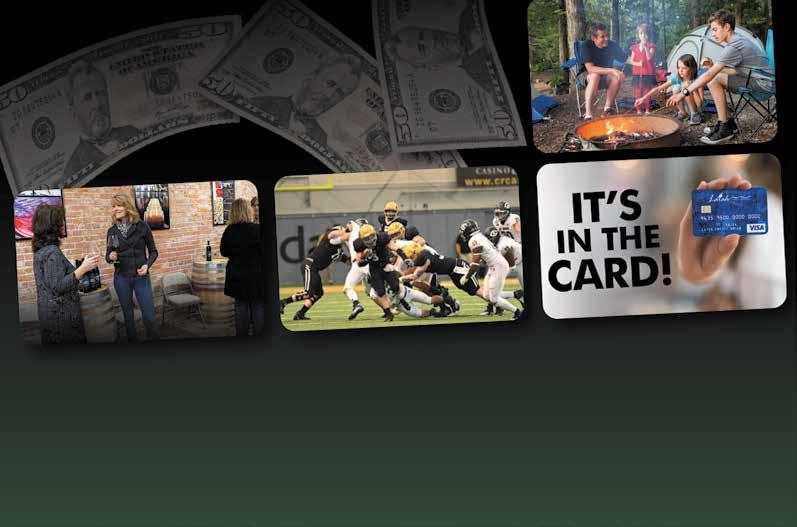

LATAHCU.COOP UI Commons|Moscow|Kendrick|Plummer|Potlatch When you sign up for a new Latah Credit Union Visa Card, you get a $50 credit on your account! O.A.C. Limited time only. Home Loans|Personal Loans|Business Loans|Credit Cards
I do, however, love when outerspace seems to come to me. I sleep more soundly when the only lights in the night sky are from sparkling stars and not city lights. I breathe more deeply when the trees outnumber the buildings. I feel more peaceful when I have space. If that sounds like you too, check the margins on what you’ve created. Is there a place to pause or do you need to work on your masterpiece a bit more to get it where you’d like it to be?
(Psst...you are the author, artist, creator of your life - place white space wherever you need it to be!)

I was going to stop here and say, “Peace out,” let you do with your space what you want, but I feel the urge to say just a little bit more. So, this space you find in your life, that I needed in mine...why is it really necessary?
If we listen to the wisdom of my son, and maybe I should do that more often, it’s about mental health. Chances are I knew that at some point, even if I couldn’t articulate it. That’s probably why teenagers spend so much time in their rooms - space to find themselves, be themselves, and be. I’d forgotten, though. I’d forgotten that the rest notes in music literally give you a place to take a breath. I’d forgotten that green space in nature was like white space in design. I’d forgotten that our muscles grow on our rest days, not when we’re lifting weights.
Space is for peace, breathing, and growth. It’s for expanding into.
So, even if you like the fast-paced city life, if you’re ready to expand in your life, be sure to give yourself space. I’m new to gardening, but I recently repotted a plant into a bigger pot and the next day it was so happy! The leaves were standing up and I could tell it really needed that extra space. I’m glad I gave it a new home with more room.
I’m glad I got a new home with more room too.
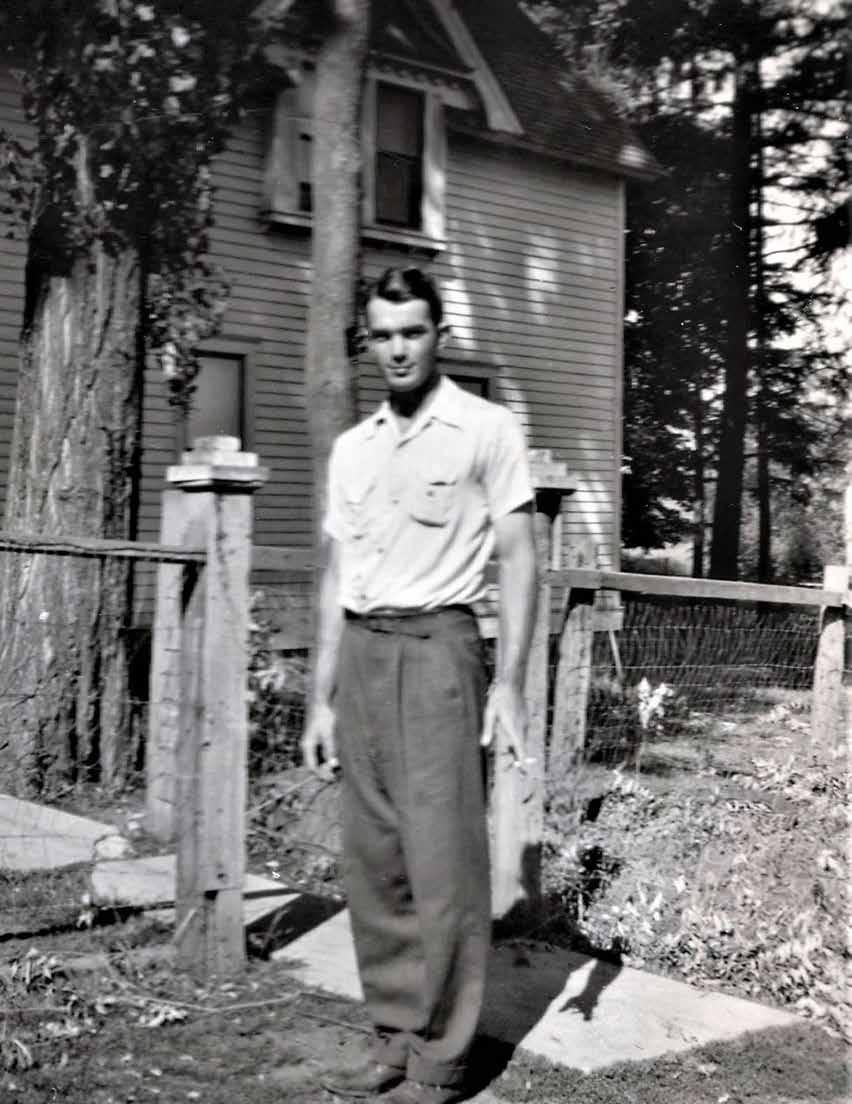
All Hands On Deck
Last issue I wrote about Henry Lorang and how he wrote his own story as he was trying to make it through the Great Depression. With the New Deal agreements brought on by President Roosevelt, the farm and family made it through these hard times and survived. There were more chickens and hogs now. And the White Spring Ranch now had a passel of kids on it as well. The 11 children of Marguerite and Henry were growing up. Grandma Mary Lorang had passed away in 1938 to join her husband John who passed in 1926. In 1938 Bob Lorang, the oldest of 11, graduated from Genesee Highschool and was very interested in radio. His younger brother Jim followed him in 1939 and was also very much into radios. Jim even made his own, which many people did at the time. It was the computers and connections of their era and they did very well with these new devices.
Bob Lorang decided to check out Spokane, looking at Kinman Business University. Aunts and uncles, some of Henry’s brothers and sisters had done well there and were now successful in business. Aunt Viola was the owner of a thriving Secretarial Service business in California. Jim went another direction and became a student at the U of Idaho. Both Bob and Jim were interested in photography. Jim created his own darkroom in the old upstairs of the 1884 section of the farmhouse as he was learning how to take closeups of the family and friends. We are lucky to have some wonderful photos they took of the younger children at this time. Joan, John, Mary Frances, Dan, Lois, Mae and Albert were all in St. Joseph’s Grade School or Genesee High School working away at their schoolwork, passing notes and writing letters which were all preserved. Mother Marguerite was driving to Lewiston and around the area selling eggs. Henry was still writing and spending some time in the hospital again after his lungs were damaged during WWI. Marguerite wrote Henry a letter saying how things were going without him.
“Genesee, Idaho
Jan. 12, 1940
Dearest Henry, ……Well, Honey, I sold the hogs and spent the money $152.67. Farmer’s Union Producers Co. $23.60. Washington, W.P. $10. Cash Hardware $1.96. Paul D. $5. Telephone $4.25. Catherine $16.20 and Gray’s Auto Shop is payed and I still have enough to pay that gas bill and for gas and all. It takes 4 qts. of oil to make a trip to Lewiston. I know you could do better with everything if you were here, but I am trying me best to keep even until you get home….Well, Honey, I am stealing time to write this before I wash the dinner dishes…
The egg business is terrible. Yesterday we had 8 ½ cases and got 17 cents for 2 cases at the hospital, 18 cents for 2 cases from Chaptman, 18 cents for case to the Pay & Packit, 17 cents for 2 cases from the Manhatten, and the other case we stored at Huggan’s until next week as I feel sure they will be up.
Last week we had to take one case to Huggan’s and only get 12 cents for them as it was 6 o’clock and we still had it on hand. I could have left it to the 24th St. Grocer but I thought I would rather take it to the creamer tho for that price rather than give it to the Grocer at their figures and let them set the price all the time.
by diane conroy
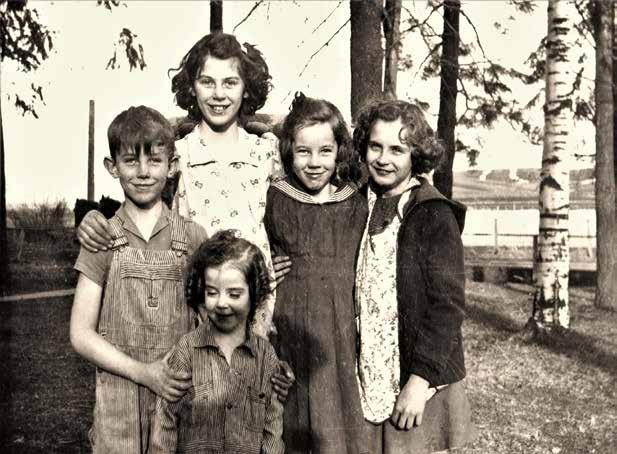

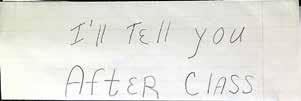 Photo, left: 1942, Lorang kids, Albert, Lois, Mae, friend Betty Scharnhorst and Rita Lorang in front.
Photo, above: 1944, School note by Mae Lorang
Photo, above: c.1945, Cousin Bud Jones with daughter Julia.
Photo, left: 1942, Lorang kids, Albert, Lois, Mae, friend Betty Scharnhorst and Rita Lorang in front.
Photo, above: 1944, School note by Mae Lorang
Photo, above: c.1945, Cousin Bud Jones with daughter Julia.
Chaptman told me he could get eggs for 14 cents trade. I told him if that was the kind of egg he wanted alright. But he took 2 cases and gave me $10 cash and 80 cents trade…….
Albert is driving me crazy asking me to write to Dady for him, so please write to him. Albert says to tell you we took the Xmas tree out.
Well Honey, I must stop and fix the fires.
Love from all, Marguerite”
As difficult as this was, during the Great Depression there was no cash at all.
But in the later ‘30s there were a lot of adventurous speculations in newspapers and magazines about new designs for airplanes and cars and television and some were pretty wild. These papers were all preserved. Bobbed hair and lighter clothing for women were now mainstream. Rural Electrification was being set up and Henry took photos when it came to the farmhouse. The future looked much brighter after the hardships of the Great Depression that still lingered. But rumblings of a great War were beginning to be heard.
After WWI, many people were against entering any war in Europe including the President; but very gradually the sentiment changed partly because of the battle of Dunkirk. In the summer of 1940, Allies were losing the battle for France on the Western Front, when the Germans drove the French and English soldiers to the beach. And then came Pearl harbor in 1941.
The U of Idaho 1941 GEM student album has a quote from then President Harrison C. Dale:
“To live in these great times and have your part in Freedom’s crowning hour. That you may tell your sons who see the light, high in the heavens—their heritage to take. I saw the powers of Darkness put to Flight.
I saw the morning break”
The News splashed over all the local papers, through radio and most definitely through word of mouth. All of these newspapers and magazines were saved here.
Then in 1942 Americans were spurred into action. Men were signing up left and right, until there are hardly any men at all left in the neighborhoods to perform the work outside the home. Jim Lorang also signed up in 1942 to serve as Radar Operator on the USS Saginaw Bay. He was the first to leave for service, taking photographs of his younger brothers and sisters before leaving. Bob Lorang was in the hospital with a double hernia and needed to heal before entering service. The doctors told him he had to wait. Jim’s cousin-in-law, Bud Jones said goodbye to his newborn child, Julia. Kids and families remaining all over the States were gathering newspapers, cardboard and scrap metals for “Salvage for Victory” drives. The magazines and newspapers we have survived these salvage drives.
The younger John Joseph Lorang, son of Henry and Marguerite had to write a note about how he was a needed to work on the farm as a service to his father and couldn’t be drafted… until 1944 when he entered the service. When John just out of highschool, did eventually leave; he carved his initials and date in the old auto garage door. It’s still there today. As is his darkroom.
Cover photo: 1942, Jim Lorang
Photo top: 1944, John Joseph initials in the shed door

Photo second: 1938, Bob Lorang

Home&Harvest July/August 2021 27

Heidi Pederson BY
My name is Heidi Pederson. I am a single mother who works and lives in Pullman, WA. I grew up with a grandma who was an English teacher and volunteered at the Moscow Public Library. Through my grandma I gained a passion for reading. I hope to instill the same passion in my daughter. Over the last year reading has really helped me get through the pandemic. Through reading I have been able to dive into an alternative universe and become part of the book, at times helping me clear my head of the challenges the pandemic has presented. I will read just about any type of genre. Some of my favorites are thrillers, mysteries, criminal, law, and historical fiction. I was recently gifted a membership to Book of the Month Club that provides a wide selection of books to choose from. Through this membership I have been able to read books that I wouldn’t normally read and have found some of my favorite books. I look forward to sharing reviews of various books with you and who knows, maybe you will find your next favorite book through one of them.
The Midnight Library by Matt Haig

If you were given a second chance to make a life decision, would you do it differently? If you could see all of your regrets in a book and change them, would you? Have you ever wondered where you would be in life had you said yes instead of no? Asked out your secret crush? Applied for that job you didn’t think you were qualified for? What if you could go to a library and see this all for yourself? Would any of these other choices lead to a life truly better than your current one?
In The Midnight Library we find Nora Seed in this exact position: faced with the decisions she has made and the possibility of changing her life for a new one. She is in the in-between known as The Midnight Library. Here, the shelves go on forever and every book is a different outcome of how her life would have gone had she made a different choice. All she has to do is open a book and she is trying on a different life.
Matt Haig crafts a beautiful story about choices, consequences, regrets and outcomes. His writing sucks you in from the first sentence and continues to captivate you with details. This story is science fiction meets alternative universe, with real life choices. Matt packs a lot of detail into short, fast-paced chapters that will leave your head both spinning with what you just read and wanting to read “one more chapter” before you stop reading for the night. Matt writes with his heart.
This book showed me that there is true power in every decision we make in our life, no matter how small. I try to not live my life with regret. I am a person who believes that everything in life happens for a reason and I live with the motto that every decision I made was the best decision at that moment, with the information I had. Hindsight is always 20/20 they say. However, this book had me thinking about the choices I have made in my life. Wondering where I would be if I had said no instead of yes, or yes instead of no. What direction would my life have taken if I didn’t move back to my hometown or had taken a different job? This book had me staying up until 1am reading “one more chapter” to see what Nora would do next.
I will recommend my daughter read this book when she gets older, just for purposes of learning that every decision you make does have an affect on your life, whether currently or years from now. It all comes back around.
I rated this 5 books out of 5 books. I would recommend every person read this. It is definitely a thought provoking, question starter of a book that makes you pause and ask yourself the “what if’s”. Until next time fellow readers. Happy Reading!
Are you a local author who would love to be considered? Send your information to: Heather@HomeAndHarvestMagazine.com

OPG – how can I explain it? You have a grill in your backyard, or out on your balcony. I’m just going to go ahead and assume that statement is true for everyone reading this article (except maybe my mom). So if you have a perfectly good grill at home, why on earth would you want to go use the dirty grill in the park?

Because your grill is at home. This grill is IN A PARK! Duh.
So today I wanted to tell you a little about some of my favorite habits for using other people’s grills. OPG.
Step one is simply to come prepared. This isn’t going to be 20 second walk from your kitchen. So it would be unthinkable to show up without the ketchup or buns, right? Well when we extend that way of thinking just a little, using a public grill becomes a lot less scary or unknown. You have to bring a few essential supplies, and in doing so you will be ready for any state of cleanliness or disrepair you may find when you arrive.
For starters, I like to bring an extra trash bag or brown-paper grocery sack. In addition to that, I’m always going to have a plastic shopping bag and some aluminum foil. Why? Because I just go ahead and assume that the griller before me left a mess. Its okay, nothing but love here, because I’m out grilling in the park. I got that cleanup for you friend, and while I’m at it, I’ll go ahead and clean up again after myself for the next griller in line. You can leave your grill at home a mess if that’s just how you want to live life, but really you should have a bit more thought for others in the park.
So when I arrive, I ball up a little foil and use it to quickly scrub along the cooking grates. No deep cleaning here, I’m just trying to knock loose any stuck-on food that survived that last use. I see a lot of people bring their grill brush from home, but I like to pack clean-in and dirty-out so I leave my brush behind. I find that the foil in this step along with the secret weapon I’ll share later that always gets the job done.
by tony niccoli
Next, I stick one paw into that plastic grocery back, and the other one holds my trash bag or paper sack. Scoop goes the ashes that were piled up in the grill along with any other trash I may find. Easy peasy. And then I just slip my hand out of the plastic bag so it falls into my bag and onto the top of the ash pile ready for a second use to clean out any crud my grilling leaves behind. This is a griller’s way of paying it forward.
And no, its normally not perfect. I could spend an hour cleaning one of those things with a metal grill brush and trying to detail the firebox only to still have a nasty, sometimes rained-on, sludge of ash still coating the bottom. No worries. Step two is clean it with fire!
I have discovered precious few things in this life that pack the cleaning punch of 700 degree flame. So once you get all that ash out of the way, go ahead and pile up your charcoal.
Are you a lighter-fluid lover? I won’t judge you. Promise. The honest truth is a love smelling a little bit of the old nostalgic accelerant on other people’s grills. Its sweet, and pungent, and feels like summers past. I just hate tasting the after effects when I cook, so I swore off the stuff years ago. At home, when I run my smoker or use my charcoal grill, I simply fill a metal chimney with lump charcoal and toss a sheet of newspaper in the bottom.
It’s a perfect light every time and the paper is long gone before the first coals begin to really flame up. No residual smells or flavor for the cooking. But in the park or camp sight, you are working with a fixed-top grill. You might be able to raise or lower the height, but you can’t just get those grates out of the way to pour the lit charcoal out of a chimney. Plus, I already told you I don’t bring along my dirty grill brush, so you know there’s no way I’m packing a charcoal starting chimney in the car.
For my tastes, the best solution is natural briquettes and patience. Build a proper pyramid and give them time to fully ignite. Yes, at home I’m a lump-purist because it’s the most natural fuel source. You are working with pure lumps of pre-burnt wood. The essence of charcoal! But to make briquettes that are all uniform shape and easier to light, companies grind up that burnt lump charcoal and pack it full of binders and fillers to get that shape. Still, if you look out for a natural briquette I find it to be a pretty good compromise for the occasional cook in the park. And choosing not to use lighter fluid from the bottle does force me to use a paraffin wax starter-cube but I’ll happily take that over self-starting charcoal that has been soaked in fluid or is in a treated bag. I just put one into the bottom center of my pyramid and tuck another one near the bottom front that I can get to with a lighter. If you haven’t discovered these yet, just check your favorite grocery or hardware store. Its quick, painless, and give just enough time to enjoy a beer or prep for food while the fire gets going.
So now all of our coals are ashed over and are just a little powdery white. The temp on the fire is very high and the grates have been thoroughly cleaned in the flame. For me, its time to spread out that pile of coals and break out the onion and oil. If you still feel a little squeamish here, a grill mat works perfectly, or the good old layer of foil with some holes poked in it before you lit up the coals. But since I like to cook directly on those greats, I give them a final cleaning and seasoning with my onion trick. I cut the onion in half and grab it with my tongs. Then just dunk it into a little Tupperware of oil, or even drizzle the oil directly on the onion. Scrub the grates with your onion-head grill brush and the oil coats them so your meat won’t stick while that onion singes and gives a little added flavor. Any bits of ash or remaining food will come off easily as you make your first few passes with the onion, so you’re ready to cook.
That wasn’t so hard was it? Bring the bags for ashes and trash, the onion and oil to season and a couple of little paraffin wax cubes to start the coals. Get your burgers or brats on there, sit back, enjoy the park, and pretend that you don’t see the jealous stares of everyone else wishing they had thought of grilling this afternoon. Let that delicious smell make its way to all those salivating gawkers and be the griller that’s down with OPG. Ya, you know me.

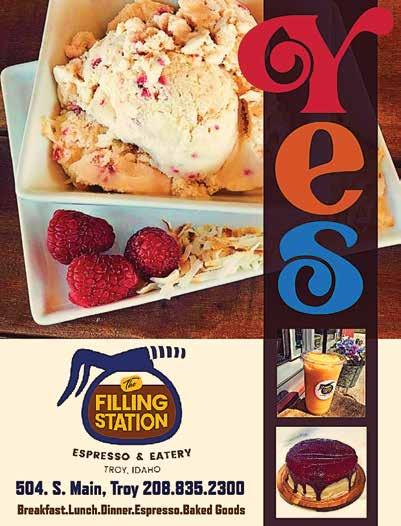

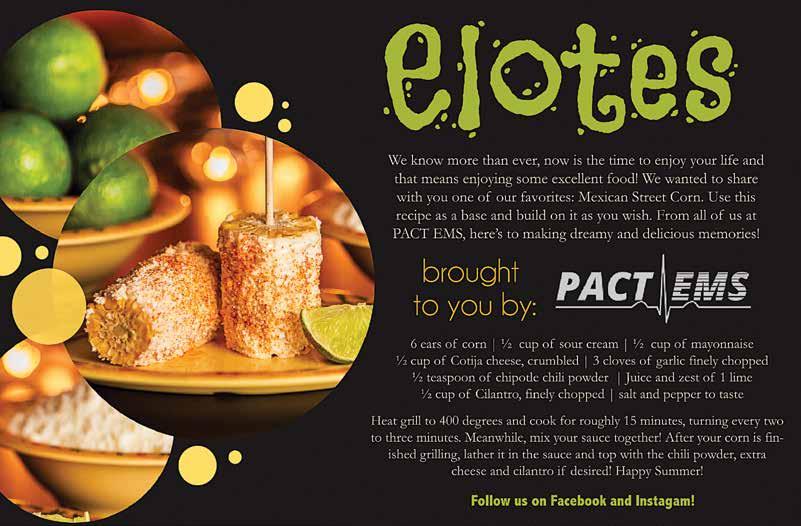
Thin Mint Cake

Sara Raquet
Chocolate Cake
2 ¼ cups all-purpose flour
2 teaspoons baking soda
½ teaspoon salt
½ cup butter
2 ½ cups packed brown sugar
3 eggs
1 ½ teaspoons vanilla extract
3 (1 ounce) squares unsweetened chocolate, melted
1 cup sour cream
1 cup boiling water
Thin Mint Frosting
16 Thin Mints crushed ( Reserve ¼ cup for the top of the cake)
1 C. butter softened
8oz Cream Cheese Room Temperature
1 tsp. vanilla extract
1 tsp. peppermint extract
2 Tbsp. milk
4-5 C. powdered sugar
A few drops green food dye
Chocolate Ganache
2 4oz quality semi-sweet chocolate bars finely chopped
1 cup of heavy whipping cream
Instructions
1. Preheat oven to 350 degrees and grease 2- 8 inch cake pans.
2. Sift together the flour, baking soda and salt. Set aside.
3. In a large bowl, beat 1/2 cup butter or margarine and 2 1/2 cups brown sugar until well mixed. Add eggs one at a time. Beat in the vanilla and melted chocolate squares. Add 1/2 the sour cream and then 1/2 the dry ingredients to the butter mixture until well blended.
4. Add the remaining sour cream and dry ingredients to the batter. Stir in boiling water.
5. Bake for 22-25 minutes or until an inserted knife comes out clean.
4. Let cool.
5. Thin Mint Frosting: Beat butter and cream cheese until smooth. Add vanilla, peppermint, milk, and 3 cups powdered sugar. Continue to add powdered sugar until you reach your desired consistency. Use food dye to get a green color and then stir in your crushed Thin Mints.
6. Ganache – Heat Heavy Whipping Cream in microwave until hot (30 second intervals). Pour hot cream over chopped chocolate. Let stand for 5 minutes. Whisk the chocolate and cream together until fully combined.
6. Frost cooled cake and top with Chocolate Ganache then sprinkle1/4 cup reserved crushed cookies on top. Pipe frosting around the edge and add whole Thin Mints if desired.
z
Home&Harvest July/August 2021 35
Gluten-Free Vegetable Skillet LasaGna
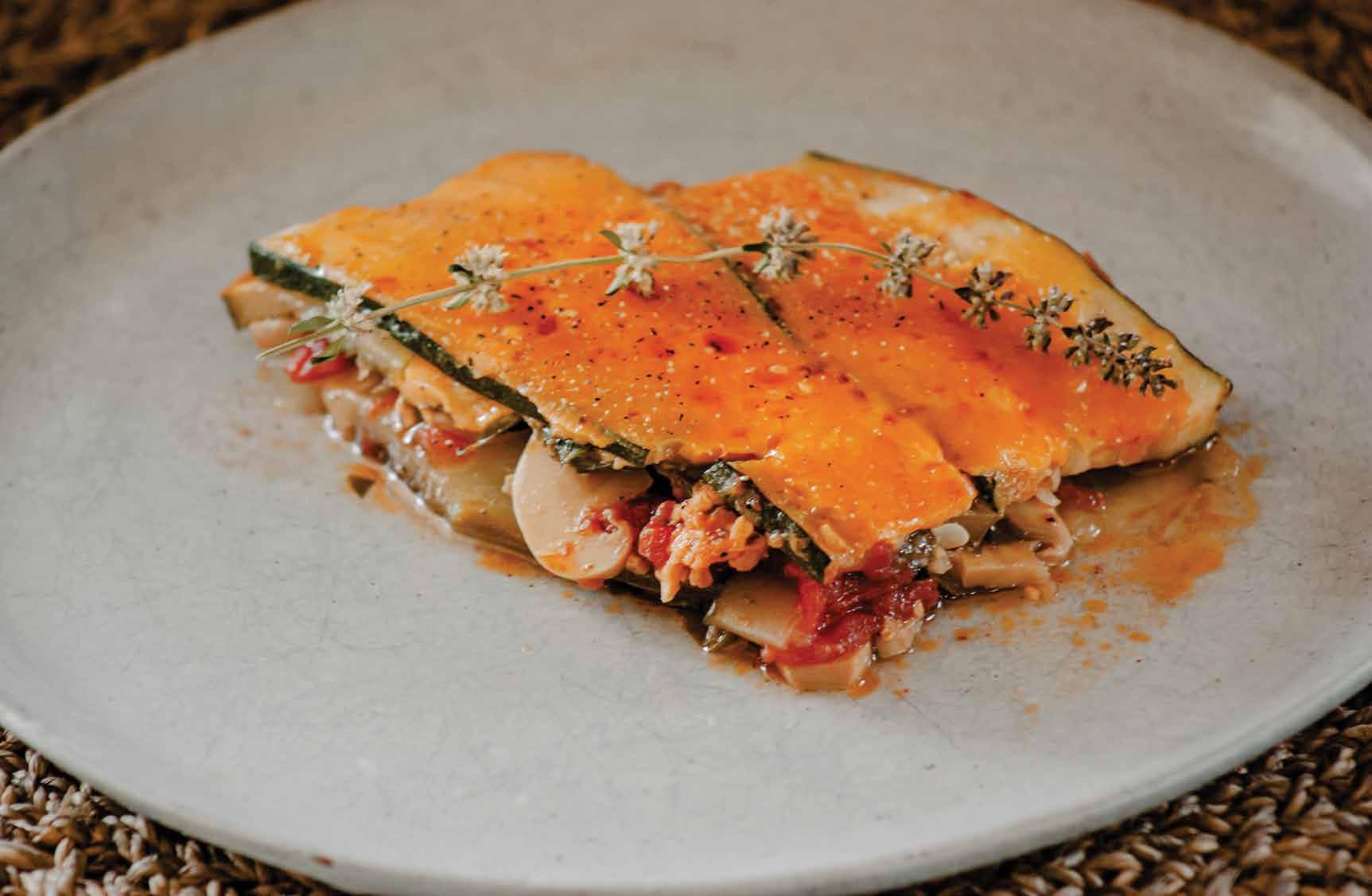
emory Ann KurySh
Not only is this lasagna gluten-free and vegetarian, but I also made mine with dairy-free cheese! Talk about healthy! But you can certainly substitute some cheddar or mozzarella cheese for the dairy-free kind, as well as add a bit of hamburger meat (provided you have cooked it beforehand). This is something that I love to make in the summer months when we have a ton of fresh garden vegetables and only about 20 minutes to cook up a feast! It’s amazing!
Ingredients:
2 tbsp oil, any kind
1 large zucchini, sliced
1 cup spinach
1 cup mushrooms, diced
1/2 small yellow onion, diced
1 can diced tomatoes
2 cups grated cheese, any kind
Salt, to taste
Pepper, to taste
Steps:
Heat oil over medium in a skillet. Lay down a layer of zucchini. Spread the spinach on top, as well as the mushrooms, onions, tomatoes, and 1 cup of cheese. Then add the remaining zucchini and cheese. Add desired amount of salt and pepper. Cover and continue to cook over medium heat for approximately 20 minutes, or until vegetables are cooked through. Then remove, slice, and serve!


Raised Doughnuts Emory Ann Kurysh
Makes 1 dozen
Ingredients:
1/2 cup granulated sugar
2 tbsp butter, plus more to grease
3/4 cup buttermilk or soured milk, hot
1/4 cup water, hot
1 1/2 tsp active dry yeast
1 large egg
3 1/2 cups all-purpose flour
1 tsp ground nutmeg
1 tsp salt
4 cups oil
Icing Sprinkles
Steps:
1. In a large bowl, combine the sugar, butter, milk, water, and yeast. Stir. Let stand covered for 10 minutes.
2. Next beat in the egg. Add the flour, nutmeg, and salt and mix until well combined. Knead in bowl until consistency is firm yet not too sticky. Grease a medium-sized bowl and place dough inside. Cover with a tea towel and let stand for 1 hour.
3. Punch down dough. Move to a floured surface and roll out into one long strip. Divide into 12 balls. Poke a hole in the centre of each ball using your finger. Work into a nice, even, smooth shape of a doughnut. Repeat. Cover and let rise for 30 minutes.
4. Drop each doughnut into a deep fryer or lightly boiling pot of oil. Cook for about 1 minute on each side, then remove and place onto tea towel over a cutting board or cookie sheet. Let cool.
5. Finally, decorate as desired! I glazed with icing and then topped with sprinkles. Have fun with it! They’re yours to enjoy.
Home&Harvest July/August 2021 39
Living a Low Waste Lifestyle

emory ann kurysh
“… [W]hen we say ‘we threw something away,’ what do we really mean? … After all, our discards don’t just evaporate because the garbage man whisked them off. Our waste end up in our landfills, spoiling our precious environment, leaching toxic compounds into our air and soil, wasting the resources used to create the discarded goods, and costing us billions of dollars each year in processing.”
“Zero Waste Home”, Bea Johnson

I feel as if there was a bigger discussion about zero-waste and low waste lifestyles in the media before this global pandemic hit. Obviously, the latter took precedent for critical reasons. However, as the world is slowly returning back to a sense of normalcy, the environmental concerns (that really never stopped) are also returning to the limelight once again, and the reception towards these issues has not always been the warmest. In writing this, I hope that it comes across more as something that may interest you enough to perhaps try out a few methods as opposed to sounding preachy and condescending. For I, too, am still learning how to live a lower waste lifestyle.
Now the term “zero-waste” is a bit of a controversial one. Some say that only those that come from a privileged walk of life can fully embrace these practices. To that, I will argue that it is quite the opposite. In fact, I will explain how becoming a less wasteful household has saves us hundreds of dollars each year. Additionally, I am not sure if anyone can ever truly be zero-waste, try as they might. Instead, adopting more low waste practices here and there seems much less stressful and more attainable than being totally free of creating waste.
That said, let’s begin!
Recycling
“ [Recycling] conserves resources, saves energy, helps protect the environment, reduces landfill, saves money, cleans the oceans, saves the natural habitats, creates jobs, supports the local community, [and] raises overall environmental consciousness.”
www.norcalcompactors.net
There are not enough positive things to say about recycling. If you are lucky enough to live in an area where you are given a separate garbage, recycling, and compost bin for pickup, I highly suggest taking advantage of those. Your city has taken a big initiative to keep garbage and recyclables separate, so it kind of seems like the least we can do is take advantage of that. I suggest keeping a smaller recycling bin or box inside your home to collect your recyclables rather than having to take the items out one by one. It’s amazing how will greatly reduce your overall daily waste as well.
Personally, we live on an acreage and are not offered any of those services. We store and haul away our own trash to the RM dump, compost a lot of our food, and take all of our recycling to depot bins located in various spots around the nearest city. These bins accept all paper, plastics, aluminum foil, tin cans, milk jugs, cartons, glass bottles, jars, and plastic bags. The only items that they don’t accept are hazardous materials, electronics, clothes, food, and tires. (We take our electronics to a separate recycling depot and donate whatever clothes we have grown out of.) An added bonus is that you don’t have to separate the different types of material beforehand. Simply drop them in and away you go!
Bottle recycling is obviously one of the best examples on how living a low waste lifestyle can help you save or even make money. Not to mention its beneficial impact on the environment.
Finally, I must address the notion of plastic wrap. It was something that I used all of the time and never thought twice about. However, the devil is in the name- plastic. Not only is it made of harmful chemicals but it is nearly impossible to break down. And where does it always end up? The landfill. Instead, there are five easy alternatives to using plastic wrap, such as beeswax wrap, cloth bowl covers, storage containers, silicone lids, and lastly, aluminum foil. I am going to highlight the last one for a minute. It is really the only thing that we now use to preserve our food. Why? It is so inexpensive and durable and the best part is that it’s recyclable! After we are done using it, we rinse it off, ball it up, and throw it in our recycling bin. How awesome is that?

Composting

“In recent years, only an estimated 38% of food was composted in the US. Food scraps make up about 30% of everything we throw out … not only that, when we send our food scraps to the landfill, they decompose with no air, creating the greenhouse gas methane – a gas that is 34x more potent than CO2.”” “Composting diverts food scraps from landfills and creates rich, nutrient soil that can be used to grow more food- it is truly circular!””

wastefreeplanet.org
“So why is it so important to keep organic matter out of landfill anyway? Won’t it just breakdown there? Well basically, no.”
“Landfill areas are so densely compacted that there is not enough microbes, air, light or moisture for organic matter to breakdown. Did you know that they have found 20+ year old intact carrots in landfill!?! Compared to my worms who could break down a blended carrot in a couple of hours…”
“When organic mater does begin to breakdown in landfill, it does so anaerobically (without oxygen), which produces greenhouse gases as a byproduct.”
“So by throwing your organic scraps into your curbside bin you’re ensuring they probably wont break down – and if they do, they’ll produce green house gases.”
wastefreeplanet.org
Two years ago, I had never even thought about composting. Today, it has become second nature to our family and along with recycling, has cut down the amount of daily waste in our household significantly. We also work in our composted soil into our gardens every spring and it is just so useful in adding a lot of extra nutrients. Additionally, it saves us from having to purchase bags of garden soil each year.
Composting is honestly such a simple and effective practice. Our own family ended up buying a stainless steel compost bin that we keep on our counter. But really, you can use almost anything- so long as it has a lid. I’ve read that there are those who even blend their food waste and then store it in an airtight container in their freezer. This actually minimizes the amount of time that it takes for the food to break down once it joins the compost pile. If you have the time, I think it’s such a great idea!
As for what you can compost- the general rule of thumb is if it comes from the ground then it is compostable.
Of course there are exceptions, such as eggshells, coffee grounds, and tea bags. You can even throw in nonfood items such as leaves, grass clippings, branches, ashes, houseplants, and more. This may not sound like a lot, but in reality, it is! Finally, if you don’t have your own compost pile then you can usually find a drop-off in your local town/city.
Cleaning Supplies

Cleaning supplies on the whole are usually quite expensive and very toxic. Then, the more natural the ingredients in your cleaner, the more it generally costs. If only there was an extremely cheap and safe household cleaner, so safe that you can ingest it. Guess what? There is!
Vinegar is one of the most underused and versatile household products. It can be used as: an adhesive remover, bathroom cleaner, colour set, drain cleaner, eraser sponge, flower food, glass cleaner, herbicide, insect repellent, jewelry cleaner, kitchen cleaner, laundry booster, mildew remover, nicotine stain remover, odor neutralizer, pet repellent, quick mop, rust remover, stain remover, toilet cleaner, upholstery freshener, vinyl cleaner, and wood renewer.
Do you need to clean your drains? Sprinkle some baking soda inside and add vinegar. Kill weeds? Use straight vinegar. Boost your laundry colors? Vinegar. And for an all-purpose cleaner? Simply dilute 1/4 cup white vinegar with 1 cup water. You can even add citrus peels or essential oils to the vinegar several weeks before diluting it if you prefer scented cleaners.
So please, try eliminating your harmful household cleaners and replace them with something that is better for your skin and the environment. I don’t think that you will regret it!
Paper Towels
Now if I am writing about cleaning products, at some point I need to address the notion of paper towels. Paper towels are a huge problem. In my research I found that paper products account for roughly 25% of landfill waste. The US produces over 3000 tonnes of paper towel waste each day, which significantly increases methane gas. By cutting out paper towels it would save trees, water, the atmosphere, and us money.
When I first began this journey, I knew that I would have to stop buying paper towels. I was little nervous and skeptical at the thought of using rags to clean up our dirtiest messes, especially with young children. Still, we cut up all of our old towels and clothes and turned them into a rag collection.
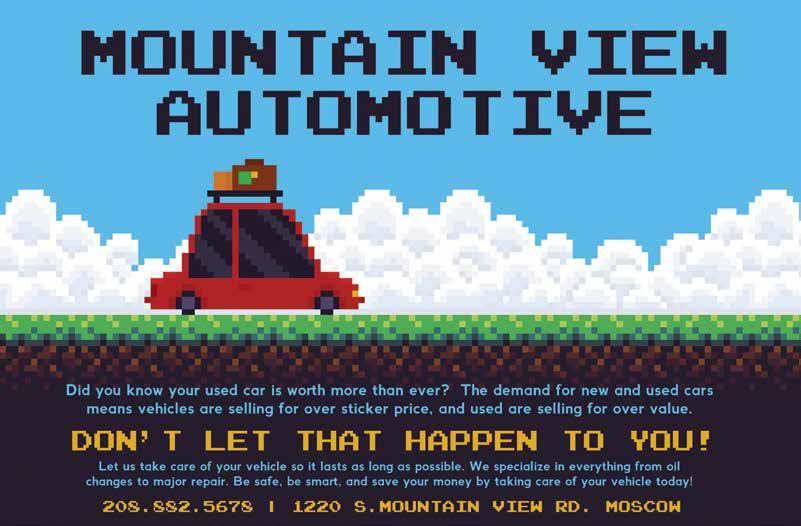




Annie Gebel's
Home & Harvest Tarot Reading

Let’s tap into our fire! What’s that mean? Well, fire represents passions, pleasures, fun, and play. You’ve probably heard phrases like ‘fire in your belly’ or ‘get fired up.’ When we’re excited about something, there’s often a feeling in our bodies that tells us so. Energy swirls in our guts. Our heart rates might increase. These reactions can happen when we’re enraged or thrilled. Excitement, and fire, comes in many forms. Think about how a fire can warm you on a cool fall night or burn down a forest if left unchecked. So, let’s look into what fires us up and get some guidance on how to work with the fire and not let it burn us out, or worse, burn us down.
Close your eyes and think about something that’s got you fired up. Maybe it’s a hobby you’re super-passionate about or a cause you want to support. Whatever comes to mind, just consider it for a few breaths, thinking about what you feel in your body when you think about this thing. Think about whether you’re frustrated, nervous, or delighted - or some combination. When you’re ready, open your eyes and look at these three cards from The Light Seer’s Tarot. The one that jumps out to you holds a message that can help you fan your flames or maybe spray a little water on your firewhatever you need.
Judgement
This is a major arcana card, or as I like to say, a sit up and take notice card. In a tarot deck you have four minor arcana suits and one major arcana suit. The major arcana cards are often thought of as highlighting a journey or project or lifetime, and when they come up they act as a sign that you might want to pay attention!
Judgement is almost at the end of the cycle (#20 of 21 cards) and represents self-actualization or personal understanding. The imagery on the card shows a woman content in who she is and seeing her essence rise. That’s the kind of beautiful honesty you’re likely feeling or going to feel in regards to feeling fiery!
Whatever topic you thought of before choosing a card is likely deeply connected to who you are at a spiritual level. It may feel risky or scary to drop all your facades and let the truest you shine, and, yet, that’s exactly what this card is suggesting you do!

To make things feel less uncertain or unnerving, try revealing yourself to yourself first, and then little by little to others. You know that the only judgement that matters is yours. Get used to seeing and thinking of yourself as the soulful, spiritual, fiery being you are. Ask yourself each morning what you can do to shine your beautiful lightthen do it! Shine bright! Shine wholly!
The cards from the suit of Swords have to do with our thoughts, our minds, and the ways we communicate. Tarot cards have meanings both in the upright and upside-down, or reverse, positions. In this case, the 9 of Swords normally has to do with nightmares and worries. In the reversed position, though, these little concerns have grown into negative self-talk, deep fears, or even paranoia. When you look at the card, you can see one white bird and a whole lot of black ones. In the reversed position, that white bird - hope - is buried under turmoil, trauma, and depression. This card is an invitation to begin healing.
Maybe mental health, yours or someone else’s, is the subject you thought of that feels hot in your gut. If it’s you, maybe that fire is currently just a little flicker, but you know it’s there and it’s time to begin taking care of your mental health. If so, you’re supported. If you’re fired up about mental health in general, what can you do to help your community address it more fully? Perhaps volunteer in some way? Think outside the box to begin making a difference. You don’t need to reinvent the wheel, but you can make changes in your world.
5 of Swords
This poor guy. When this card comes up, I just want to give him a hug. Clearly he has a headache, yet the bird won’t stop squawking. The meaning behind the 5 of Swords is that something has happened that feels like a loss or setback. It’s rocked this guy and he’s not sure how to begin rebuilding. This could refer to you or someone you know. And it’s time to start rebuilding.
If you look behind the person there’s a silhouette of a person celebrating. That symbolizes the goal - the completion of whatever idea has hit tough times. The fulfillment of this dream can happen with hard work and through the lessons learned from this setback.
With your fire in mind, consider the subject you thought of and if there’s been a setback, don’t give up or push through with frustration and anger. Taking either of those extreme positions might be easier, but won’t have lasting success. Instead, look for an answer in the middle somewhere. What did you learn from the loss or struggles? How can you change your strategy or alter your plan to reach more people? What is the crow on your shoulder and how can you send it packing? Think about these things refocus, using your fire to create the change you desire.
9 of Swords, in reverse
Who Who

Who is
Who Carol Ryrie Brink?
is
by dulce kersting-lark
Have you heard the name Carol Ryrie Brink? It hides in plain sight in a handful of places across Moscow. Maybe you have taken a stroll through Carol Ryrie Brink Nature Park near the city’s new play fields. Maybe your children have enjoyed a story hour in the Carol Ryrie Brink Reading Room, located in our historic Carnegie public library. Or maybe you have noticed Carol Ryrie Brink Hall on the University of Idaho’s campus, which was originally built as a dormitory but now houses faculty offices for the English department and others. The name is both ubiquitous and largely unfamiliar to many area locals.
Ms. Brink, who I will take the liberty to call Carol going forward, was an award-winning author who spent her formative childhood years in Moscow, and who would draw on her memories of the upstart community for the remainder of her life. Carol published more than thirty books, some for adults and many more for children. She had a natural talent for storytelling and a sincere desire to connect with her readers. Her works are rich with detail and can truly transport you to another time and place, including to Moscow at the dawn of the 20th century.
Carol was born in Moscow in 1895, just eight years after the city had been incorporated. The population hovered around 2,000 residents, meaning the small community was abuzz with activity. Hopes were high among the early investors and business class of Moscow, particularly given the placement of the state’s land-grant institution in 1889 and a strong agricultural economy that thrived in the surrounding hills. One of those adventurous souls betting on Moscow’s success was Alex Ryrie, Carol’s father. Ryrie and three of his brothers had immigrated to America from Scotland in the late 19th century. In Moscow he established himself as a leader, becoming one of the earliest mayors, as well as a successful businessman involved in the real estate and insurance fields. He and his brother Donald built fine homes on South Polk Street and enclosed their yards with a single picket fence. You can still appreciate Alex Ryrie’s vision for a striking home by driving past the intersection of A and Polk Streets; it is the “Pink House” on the corner. It was in that home that he started his family with Henrietta Watkins.
Even more distinguished than her father was Carol’s maternal grandfather. Dr. William Watkins was the most prominent physician in Moscow at the turn of the century. He operated an office in the single-story brick building on the north side of Second Street, between Main Street and the mid-block alleyway. His reputation as a skilled doctor and civic minded community member were quickly established after his arrival in 1887, accompanied by his wife Caroline Woodhouse. Dr. Watkins was a member of the Board of Regents of the University of Idaho from 1893 to ’95, as well as the president of the Idaho State Medical Association in 1893 and ’94. The couple had three daughters, Henrietta, Elsie, and Winifred, and they made their home on South Van Buren Street. The home was located across the street and just a half block north from the First Presbyterian Church, which was an important location in Carol’s early life because her father Alex Ryrie was an active and devout member. Ryrie wrote out the church’s weekly bulletin in longhand and would even add small drawings in free spaces. It seems likely that Carol inherited at least part of her creativity from her father. Despite possessing all the ingredients for a nurturing and privileged childhood, successive waves of tragedy struck Carol’s family that would forever change her life. In 1900, at the tender age of five, Carol’s father Alex died of consumption. Also known as tuberculosis, consumption was the leading cause of death at the turn of the century in America. Carol’s mother soon remarried a timber locator named Nat Brown, who proved to be a poor substitute for Alex. It was well-known in town that Brown drank too much and was an all-around scoundrel. The young girl’s once warm home was plunged into unhappiness. Then in 1901 the family was further rocked by the murder of Dr. Watkins, who was one of several victims of a Moscow man who went on a shooting spree. The shooter, William Steffens, fled to his home near the Moscow Cemetery, tailed by a posse of local men looking to apprehend him. A shootout ensued between Steffens, holed up in the second story of his home at the corner of White Avenue and Mountain View Road, and the sheriff’s posse, from which the culprit did not emerge alive.

It is often said that tragedies come in threes, and that would be the case for young Carol. The sadness and disappointment of her second marriage, coupled with the loss of her father and husband, were too much for Henrietta to bare. Carol’s mother took her own life in 1905. In the course of five short years Carol had experienced enough pain to fill a lifetime. Thankfully her grandmother, Caroline, was there to pick up the pieces. “Gram” as she was often called by Carol and others, was a woman of remarkable courage and steadfast love. Together with her middle daughter Elsie, Gram raised Carol in the Watkins family home on Van Buren. It was not a traditional home for a child, it was quieter and less lively than the homes of her peers, but it was filled with rich stories and ample space for Carol to indulge her imagination.



If you like the region, you’ll love the town! World Famous Palouse! We’ve got it all! Mark your calendars and don’t miss out on SECOND SATURDAYS! A monthly downtown community celebration DOWNTOWN PALOUSE Whitman County’s Friendliest Hometown www.visitpalouse.com VISIT! PALOUSE DAYS SEP 18 CITY YARDWIDE SALE AUGUST 7 BEAT THE HEAT! VISIT OUR SWIMMING POOL AT THE CITY PARK
Carol was a shy child, and took great pleasure in spending time alone. Gram, perhaps seeing her granddaughter’s need to work through her emotions, gave Carol a great deal of freedom to wander. She had a beloved pony named Timmy that provided her the means to explore Moscow’s bustling streets as well as the rolling Palouse hills that unfurled at the edges of town. Later in life, Carol would recall how she filled her “happy but lonely” childhood. “I made most of my own entertainment…I read and wrote and drew pictures and made doll clothes and furniture. My dolls were never my babies, but were actors in long continued stories that I played from day to day…I spent hours and hours every summer riding over the beautiful Idaho Hills, observing things around me and telling myself stories. I had seen enough trouble and unhappiness as a child to appreciate the good things and to understand serious things in life.”

Carol’s penchant for stories undoubtedly came from Gram. Caroline Woodhouse grew up in Wisconsin in the middle of the 19th century, when that part of the country was considered America’s frontier. She entertained her granddaughter with vivid tales of life in a log cabin, miles from any town, assembling life’s necessities from the forest that surrounded the family home. The well-worn stories were etched into Carol’s mind, so much so that if her grandmother missed a detail or mixed up a sequence, she would protest and claim “that’s not the way it goes!” Storytelling was a craft in the Watkins home, and one that transcended the generations.
Part of Carol’s high school years were spent in Oregon at the Portland Academy, where she began to break out of her shell. Although she had been writing prose and poetry for years, it was not until her junior year at the academy that she worked up the courage to submit a story for publication in the school’s magazine. The piece ran in the following month’s edition, and proved to be what Carol herself called a “Cinderella affair.” For the remainder of her time at Portland Academy she was published in each monthly magazine, and this once-timid girl was even escorted by the “handsome and popular” editor to the senior prom. Carol returned to Moscow the following fall to attend the University of Idaho as a changed woman. College life suited Carol well. Reflecting on her time at the university many years later, she recalled being “happy to be in the swim at last after being lonely and shy for so many years.” Her involvements were many, including being the society editor for the Argonaut student newspaper, joining the Gamma Phi Beta sorority, taking part in student events like the May Queen procession, and gaining membership in the exclusive Sans Souci club. The latter was a group formed by English professor Wilkie Collins, a man who shared his name with a great Victorian novelist, but appears to have published very little in the way of his own work.
Collins was, according to Carol, “an expansive, good-looking man with rolling nautical gait which was supposed to-
Photo, below: LCHS Photo Brink.C.06: Carol Ryrie Brink as an established author showing her Newberry Award medal to a member of her publisher’s team, circa 1960.

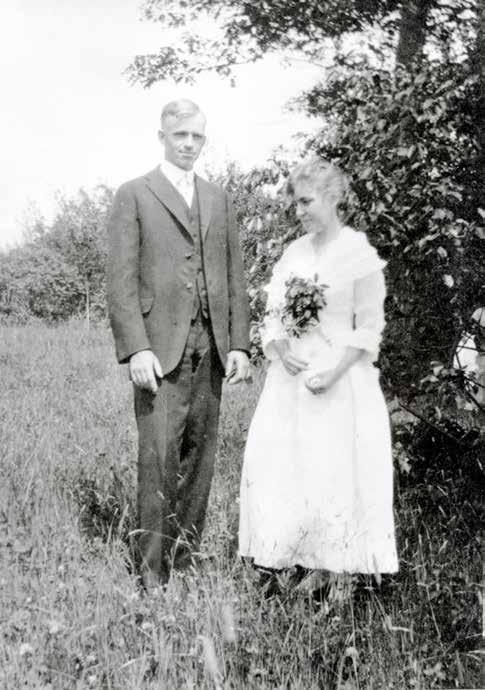
Photo, last page: LCHS Photo Brink.C.09: Clockwise from top left, Aunt Elsie Watkins Phiel, Caroline “Gram” Woodhouse Watkins, Nora Brink (Carol’s daughter), and Carol Ryrie Brink. Date unknown.
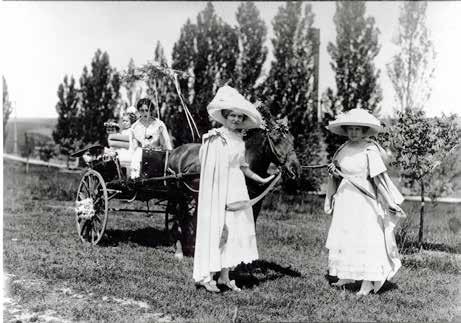 Cover Photo: LCHS Photo Brink.C.02: Carol Ryrie Brink as a young woman in the 1920s.
Photo, left: LCHS Photo Brink.C.21: University of Idaho May Queen procession, circa 1916. Carol Ryrie Brink is on the left, leading her pony Timmy.
Photo, right: LCHS Photo Brink.R.03: Wedding picture of Carol Ryrie and Raymond Brink, July 1918.
Cover Photo: LCHS Photo Brink.C.02: Carol Ryrie Brink as a young woman in the 1920s.
Photo, left: LCHS Photo Brink.C.21: University of Idaho May Queen procession, circa 1916. Carol Ryrie Brink is on the left, leading her pony Timmy.
Photo, right: LCHS Photo Brink.R.03: Wedding picture of Carol Ryrie and Raymond Brink, July 1918.
-have originated in his years of deck pacing in the Merchant Marine.” Students, and in particular female English students, were enamored with their Wilkie Collins. “This glamourous aura of having lived genuinely rather than vicariously is much more important to the freshman student than the authorities ever realized. We hung on Wilkie’s every word, uttered in a lazy drawl that seemed to roll with the sea as surely as his walk did…An English teacher, oh, assuredly more than that – an influence, certainly an influence!” Given Carol’s clear affection for her professor, expressed more than fifty years after her time in college, it is little wonder that she leapt at the chance to be part of his select group of students invited to a regular Sunday literary circle convened in his personal boarding room, located on the second floor of the McConnell Mansion. The San Souci Club, alternatively called the Sans C Club (with the “C” standing for chaperone), was made all the more enticing because “it was understood that the Dean of Women was seriously concerned. Freshman girls meeting in a man’s room with older boys!”
Despite her many social pursuits and blossoming friendships, Carol was restless and felt that there must be more to the world beyond the shadow of Moscow Mountain. Once again her desire to wander took hold and Carol chose to transfer to University of California at Berkeley for her senior year. During that final year of school she maintained a long-distance relationship with Raymond Brink, whom she had met as a teenager while Brink was teaching math at Moscow Prep School. The two determined they would marry following Carol’s graduation. Initially the couple planned to enjoy a simple ceremony in the Van Buren home where Carol had been nurtured by Gram and Aunt Elsie. The latter woman, however, felt Carol was giving up her opportunity to be a serious author and an independent woman by marrying so early, and thus forbid the young bride from marrying at home. Instead the future Mr. and Mrs. Brink traveled east to be married in Wisconsin at the groom’s family home. Later in life, Carol recalled how that trip felt to her. “The world unfolded outside the window of the railroad car,” and she thought to herself how small and isolated Moscow felt. As this final sting of disappointment faded, however, Carol’s heart would soften to her hometown.
The Brinks settled in Minneapolis where Raymond became a respected faculty member of the University of Minnesota mathematics department, and Carol happily took on the role of supporting wife, caring mother, and gracious hostess. And still she found time to write. Sometimes it was on the end of an ironing board, sometimes next to the kitchen sink, and frequently it was after the children had gone to bed. Carol was born to be a storyteller, and she could not help but share her gift with others. Her first book, a story for children title Anything Can Happen on the River, was published in 1934. Even before it could go to print, Carol was already working on her next book. Just as she had devoured the stories of her grandmother’s upbringing in the wilds of Wisconsin, Carol knew-

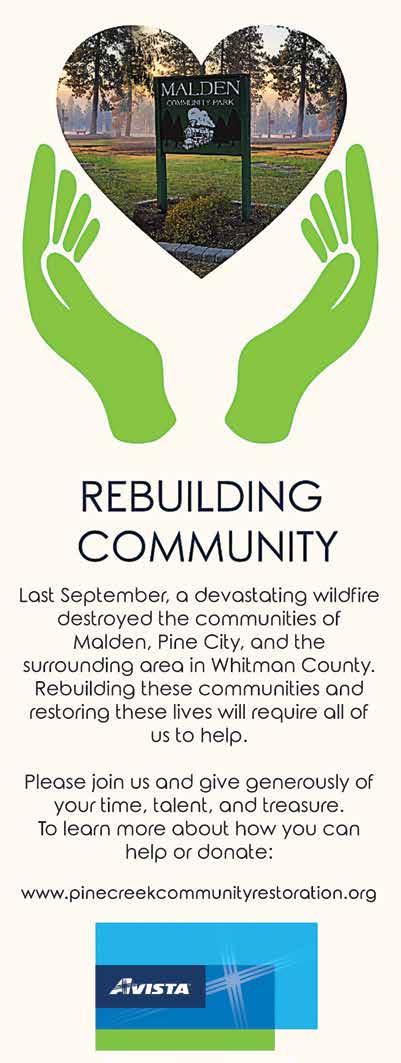
N
-that other children would delight in the details and excitement of a time gone by. Caddie Woodlawn is a children’s fiction that is deeply rooted in the real experiences of Caroline Woodhouse. Although some elements were altered in order to create a fluid narrative, the core of the book is very much true to life. Caddie Woodlawn was published in 1935 and the following year it was chosen for the Newberry Medal as the most distinguished new contribution to children’s literature. It was so popular, in fact, many children and adults hoped for a full series, reminiscent of Laura Ingalls Wilder’s Little House collection. According to one retrospective of her work, “because the children who read Caddie knew that it was based on real characters and events, Carol felt she could not misuse that trust by fabricating new stories.” Any of Gram’s stories which had not fit into the storyline of Caddie Woodlawn were compiled in Carol’s 1939 work Magical Melons.
Carol then turned her attention to writing for an adult audience. In 1944 she published the first in a trilogy of works that once again mined her childhood memories. Buffalo Coat is a fictionalized retelling of Dr. and Mrs. Watkins’ migration to Moscow, though they are recast as Dr. and Anna Hawkins, and the up-and-coming community is named Opportunity. The plot focuses on the ambitions and rivalries that most certainly fueled Moscow’s growth, though Carol uses her artistic license to interweave the stories of real individuals to add drama and intrigue. Her grandfather’s murder is a central plot point in Buffalo Coat, as is the tragic double-suicide of a married doctor and the Methodist minister’s daughter which really did rock Moscow in 1902. The publication of Buffalo Coat raised more than a few eyebrows in Moscow, given that so many residents could identify the real events and individuals that served as a foundation for her story. While Carol thought she must have been very much forgotten by that point, a great number of people still felt connected to her and the Watkins family. Indeed even three decades later when Latah County Historical Society arranged for Buffalo Coat to be reissued, locals had strong feelings about the author’s work. Alma Lauder Keeling, for instance, wrote to LCHS in 1980 to express the following:
“I assume you are wondering what a former M.H.S. classmate of Carol Ryrie Brink’s thinks of her book, “Buffalo Coat,” now that I’ve read it. Well, frankly, I can hardly say! I surely can “relate” to a lot of it, but as for liking it – well, let’s skip that. It is not my chosen kind of reading, as I much prefer a book that is an uplifter rather than a depressant! But – I guess it is more or less “early history” of our nice town.”

Carol’s other two Idaho novels, Strangers in the Forest and Snow in the River, generated less community hand-wringing but are no less captivating. Strangers in the Forest fictionalizes the experiences that Carol’s Aunt Elsie had making a go of it on a timber homestead claim near Clarkia, Idaho.

It is a story of ambition, perseverance, disappointment, and self-discovery. Carol’s mother’s death underpins the plot of Snow in the River, as do the adventures of the Ryrie brothers. Taken together, this trilogy of fictionalized stories gives the reader a very real sense of Moscow and indeed north central Idaho at the turn of the century.

Carol Ryrie Brink published more than thirty books in her lifetime, wrote several plays, and was a talented poet. Despite her many accomplishments, by the 1980s she was unknown to most residents of Moscow. It is largely thanks to the interest and dedication of one woman that we were reintroduced to our hometown author. Mary Reed, the longtime director of Latah County Historical Society, was surprised to learn after taking her post at the McConnell Mansion that one of her favorite childhood writers had spent time in that very house. Soon Mary located Carol, who was by then living in San Diego, and arranged for a meeting and oral history interview. The transcripts of those conversations now live in the LCHS archives, as do many more materials related to the author’s life and work. The resurgence of local interest helped spread Carol’s name through town and reintroduced Caddie Woodlawn, Buffalo Coat¸ and her entire catalogue to a new generation of readers.
I hope this summer you will pick up one of Carol’s books, from your local library, favorite bookstore, or our very own museum store. Not only will you be treated to an entertaining and engaging read, you will also likely gain an appreciation for the men and women who helped to build Moscow more than a century ago.





people OF the palouse
 by gayle anderson
by gayle anderson
Let’s get to know our neighbors, those like us and those who are different from us. Please send any introductions to:
Heather@homeandharvestmagazine.com
Sisouvanh Keopanapay
Imagine as a child living with your parents in a life of luxury that came complete with maids and a chauffeur, but then circumstances beyond your control changes your world overnight. And when you are age 7, you make a vow to yourself of how you are going to live your life and then as a fifth grader, an unexpected inspirational person shapes the direction of your professional life. Sound fascinating? Let me tell you first-hand, it is. I want to introduce you to Sisouvanh Keopanapay. Hers is a story of courage, hard work and most of all, hope and opportunities.
Sisouvanh, who goes by “Sis” recalls an early memory around the age of 5 that her father was instructing the maids to teach the children how to clean and dust, saying that they may need those skills someday. The political climate was changing fast and Laos was in turmoil in the late 1960’s and early 70’s. And Sis’s dad knew changes were coming, he just didn’t know the extent and what it would do to him and his family.
True to the father’s premonition, Sis and her family ended up as refugees a short time later without a country to call their own. Sis tells the story of a pivotal moment in her young eyes that was life changing for her and one that has carried on into adulthood. Sis, who was 7 years of age, was being instructed by her dad how to wash clothes in the river using rocks. Sis gets emotional and tears well up in her eyes as she shared her remembrance of the event, and as she composes herself, she recalls as this young child, she looked up at her dad and the realization dawned on her that he wasn’t wearing his usual business attire of a professional suit holding a briefcase, but rather standing there on the banks of the water in a refugee camp teaching her how to help with basics formerly done by their maids. At that moment the enormity of their situation hit her and she realized what a drastic change has occurred in their lives and how much of a heavy load this must be on her parents. A vow to herself at the tender age of 7 was to never be a burden to her parents or anyone and this has been the cornerstone to living a life of courage, determination, taking chances and seizing any opportunity that came her way.







Answer adventure’s highest calling. The 2022 Subaru Outback® Wilderness™ Serving the Palouse Communities • Short-term rehab • Physical therapy • Occupational therapy • Speech therapy • Long-term care • Respite services • Palliative care 1310 NW Deane Street | Pullman, WA 99163 | Phone: 509-332-1566 | Fax: 509-332-0909 avalonhealthcare.com
When Sis was 9, she and her family arrived in Texas and while excited, this was a whole new world of learning the language and along with its culture. But it also represented a life open to possibilities and freedoms. Sis set basic goals for herself, and that was to learn the language and to be able to read & write so she could order food. Other than attending pre-school in Laos, there wasn’t any schooling available in a refugee camp, so Sis started school in America at the age of 9. After living in Texas for a about a year they moved to Colorado and from there settled in the State of Washington. When they first came to America, Sis recalls that she and other immigrant kids were placed in a special classroom to learn English and receive special instruction. It was there that a 5th grade teacher named Mrs. Brezeale took an interest in the young refugee and pulled Sis out of the special class and put her in with her regular students. During recess and after school, Mrs. Brezeale worked with Sis to improve her English skills and assign extra help lessons. Under the teacher’s compassion and encouragement, Sis blossomed and excelled in her studies as well as social interactions with her classmates. The child/ teacher bond was held dear by both in which the two communicated until Mrs. Brezeale passed away. Having a teacher who saw something extraordinary in a young girl, unknowingly became the vocation of what Sis does for a living today, which is a being a college advisor to students. When I mentioned the correlation between the two, Sis stopped and looked at me and said, “I never thought about it like that before!”
In America, Sis’s mom was the main breadwinner working in a meat packing plant to feed the family of 10. Opting to not take any public assistance, it was a struggle financially for her family, but Sis’ never felt poor. Sis’s dad was the stay-at-home parent whose quiet guidance helped shape each child into having a strong work ethic, to be proud of their culture, be independent, as well as being the best version of themselves as possible. To earn extra income, Sis’s mom would cater Laos community events on the weekends. Her mom would give instructions for food prep and then would join them after her workday ended on Friday evening. Her dad would fix dinner and would rent a movie for everyone to watch while they worked, which was often until 2:00 or 3:00am.
At a young age, summer vacation was spent working in the fields picking berries to help buy school supplies and clothes, and in her latter teen years Sis worked a couple of summers in the same meat packing plant where her mom worked. At the time Sis dreaded the hard work from those summer jobs, but now looks back at the amazing life lessons learned where she can relate to blue collar work. Being poor in finances did not define them and her parents instilled the values of being grateful, being kind, working hard for what you wanted and to always seek-
-your dream. They appreciated their new life in America, while still honoring their culture, which meant they honored their elders and other family members. Each child was encouraged to seize the opportunities that life in America presented, and all 8 children graduated from college.
As a whole, Sis and her family felt a sense of community with other Laos immigrants. She tells the story about her dad back in the 80’s (prior to the Google maps and cells phones), that his standard way to get information if they were lost and needed directions, is that he would find a phone booth and look in the phone book for a common Laos last name. Then he would call a random number, speaking in their native language and explaining their situation and ask for assistance. She marvels that those complete strangers would offer to feed them and help them get on their way or do whatever it was needed to help the lost family. It was that sense of community that warmed Sis and her family’s hearts, people helping people. Their cultural heritage of honoring your elders and others regardless if you know them or not was that you help your fellow man, or as Sis puts it, it’s just good karma. Fast forward to today, Sis and her husband, who reside in Pullman, Washington are now empty nesters, as their two daughters are both in college. On the professional side, you will find Sis continuing in her role as a student advisor at a local college. As Sis explains, her variety of experiences growing up helps her do her job and guide the students towards their success. She is their cheerleader, their mentor and sometimes she finds she has to put on her “mom hat” and give some firm advice and direction in setting goals and putting in the hard work that is required. Success can be defined in many different ways, and for Sis, it’s knowing she did the best job she could in her personal life as well as professional life and to always strive to honor her values and her cultural heritage. And that life is what you make of it. How you frame your circumstances will either hinder you or it will be the catalyst for taking those next steps forward towards your goals. In my humble opinion, no truer words have ever been spoken.
On a personal note, while America’s Independence Day has already come and gone by the time you are reading this magazine, let us all take a moment to count our blessings as we as Americans are truly blessed. And I, as well as every American needs to remember to not take for granted the hard-fought battles and sacrifices of our service men and woman that ensures and continues to ensure our freedom. This is not lost on those refugees who come to our country, in that freedom is a privilege and affords hope and so many opportunities to its people that are only dreamed of in other countries. God Bless America.
Home&Harvest July/August 2021 61

zachary wnek by
photos + words
When you go out in the woods today, you’re in for a BIG surprise.
In the National Forests of Idaho, you will find all manner of interesting and exciting features, from unique wildlife to the fantastic natural environment. One thing is unavoidable if you’re in the woods of north-central Idaho:; trees.
During the 19th Century, the United States was following the trail-blazing Meriweather Lewis and William Clark and expanding westward into lands owned by native peoples who had lived here for centuries. Throughout this expansion, natural resources were harvested along the way. By the early 20th Century this natural resource harvesting reached Idaho when William Deary, a lumber surveyor for the Potlatch Corporation, came upon the vast White Pine Forests of North-Central Idaho.
The Western White Pine has become a sought-after cash crop for the lumber industry. The Potlatch Corporation was so intrigued by the area that they built the largest White Pine mill in the world in Potlatch, Idaho. Heck, the Potlatch Corporation created (and owned) the entire town of Potlatch, Idaho. Serving as both their corporate headquarters, main mill site, and an international community of lumber workers. This served as the springboard from which companies like the Potlatch Mercantile were born.
Lumbermen like Leo Guilfoy recall life in the woods, “I used to go out and cut all my wood, y’know, but I cut tamarack and red fir, that was the best firewood. In those days everything was free. But you couldn’t touch white pine. You could touch everything else, but not white pine. ... Years ago white pine was the lumber in the house. They’d make your cabinets, and all that, built-in, out of white pine. It’s a light, it’s a nice colored wood, and easy to work.”
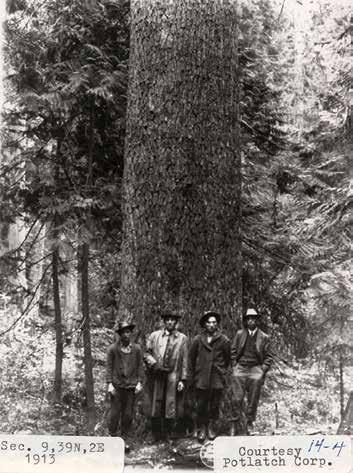


FIRST EVER
BE HERE FOR THE LARGEST GATHERING OF VANDALS. IN ONE PLACE. EVER.
LEARN MORE by calling of the Office of Alumni Relations: 208-885-6154
STAY CONNECTED by signing up for U of I emails: uidaho.edu/count-me-in
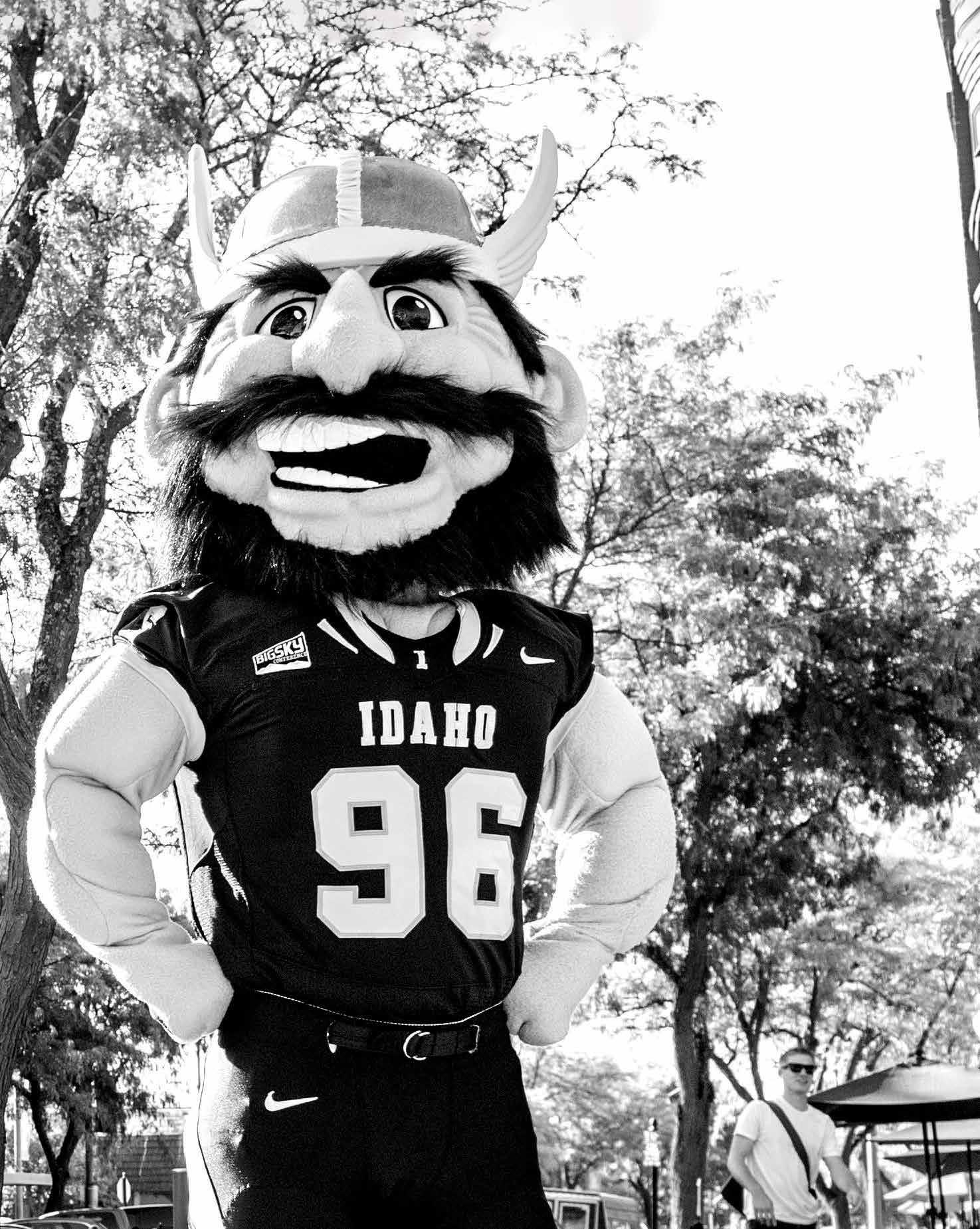
SEE YOU IN OCTOBER.
THE LINEUP:
n ICCU Arena grand opening celebration!
n Brave. Bold. Kickoff of a landmark experience to celebrate our future!
n Homecoming fireworks, serpentine, bonfire, parade, tailgate and more!
n Vandal Football vs. Portland State!
OCTOBER 7 – 9 | MOSCOW #GoVandals
Think about what might happen in the next 3,000
“ “
“The central mountains of Idaho, while they support a considerable forest cover, are poor in this regard when compared with the northern part of the state, where the forest wealth is developed second only to that of the Pacific states in economic value. Here we claim to have only large amounts still standing of magnificent white pine - a different species to be sure, from the Michigan pine, that is just furnishing its last logs to the mill - yet a very good substitute. Here larch of dimensions and quality superior to the famed European article invites the miller, and giant cedar with trunks up to twelve feet in diameter cast a sombre gloom over the mossy floor of the deep valleys. Red firs, lifting their spires 200 feet above the mountain side, suggest the yet greater forest wealth of the Pacific coast.” The Idaho Scimitar, October 3, 1908, page 9.
As you can see, when it came to lumber in the early 20th Century, White Pine reigned supreme. However, there were plenty of other trees in the forests. One such tree is the Western Red Cedar.
Luckily for us, the cedar was not as profitable during the time of extreme lumbering in north-central Idaho. I say luckily for us because it means that some of the most impressive examples of this species on Earth are still standing. This summer, you have the unique opportunity to visit one of the oldest stands of cedar in North America and possibly the world. These cedars stand northeast of the current community of Elk River, Idaho, in the Nez Perce-Clearwater National Forest.
The adventure lies in getting to the trailhead. This exciting gravel road journey takes you along tributaries to the trailhead. Officially the trailhead can be found on Country Road 382. However, I’m here to tell you that no such signage exists once you get to Elk River, Idaho. Take a few moments to explore Elk River. Take your time to grab a coffee, snacks, and or lunch before heading up on your adventure. Make sure to bring plenty of water to ensure proper hydration on your Idaho summertime fun.
Once you’re ready to leave Elk River, Idaho, follow the signs towards Elk Creek Campground. These signs will lead you to Country Road 382. From there, follow the signs to the Giant Cedar trailhead. Be sure to take your time on this majestic gravel road as it twists and turns through the National Forest. Enjoy the striking viewsheds that only central Idaho can offer.
After 10 miles, you will find parking at a well-marked trailhead. The trail is an incredibly accessible and straightforward hike. In my opinion, the ease of the hike allows you to marvel at the giants you have the pleasure of walking around.
The highlight of the trip is the Giant Cedar that bears the name of the trailhead. This tree is 18 feet in diameter and approximately 177 feet tall. When I write that sentence, it doesn’t sound nearly as impressive as it should. Go outside, take a measuring tape and measure out eighteen feet. Now walk the distance of 18 feet. That’s the diameter of this massive giant. Remember from your geometry classes that the circle’s diameter is the distance between any two points through the center.
Now for the truly impressive part. This tree is estimated to be 3,000 years old. Take a moment to sit under its shade and try to wrap your brain around the changes (good, bad, and otherwise) that have taken place in the Inland Northwest over the last 3,000 years. Think about what might happen in the next 3,000 years. After deep contemplation continue exploring this unique area.
This giant has friends. There are many massive cedars for you to walk amongst on this short 1/2 - 1 mile hike. Take your time to drink in these trees, but be mindful of others as you spend your time staring into the clouds, wondering if there is any room between where these monsters end and the clouds begin.
While you are out near Elk River, Idaho, I recommend hiking the Elk Creek Falls trail. This short and well-maintained trail can be accessed by car. Drive on Idaho Route 8 North of Elk River, Idaho, and follow the signs to the Elk Creek Falls. Unfortunately, the signage on this gravel road isn’t great. The best direction I can give you is to follow the main looking road all the way until it ends in a parking lot and turn-around.
The Elk Creek Falls trail is a short trail that takes you to three viewpoints the Upper Falls, Middle Falls, and Lower Falls. While all of these viewpoints are incredible, I particularly recommend the Middle Falls. The Middle Falls of Elk Creek Falls is the largest waterfall in Idaho!
We get stuck inside our offices all too often and have trouble finding the time to get outside. So this summer, I challenge you to take some time to get outside and explore our unique communities and natural spaces around us. These are just some of the phenomenal natural beauties easily accessed within the magnificent, beautiful, and outstanding central Idaho. Happy exploring, and I hope to see you on the trails!
years...
Home&Harvest July/August 2021 66

 by Joe Evans
by Joe Evans

The first auodad I ever saw was many years ago and was actually mounted on the wall of the Moscow gas station/sport shop. The beautiful coloring, graceful curved horns, long lower leg hairs called chaps, and overall rugged beauty of this beast made it the most outstanding, to me, of all the wild sheep in the world. It was imported into Texas many years ago. The auodad has done well due to the similarity of the territory to its native north Africa. The chance to actually hunt this grand creature occurred this past April. My wife and I drove down to Texas for a guided hunt on the Ox Ranch. Theirs turned out to be a real class act outfit at a reasonable cost. I’m glad to know good deals still exist if you look! I took two Weatherby rifles to Texas on this hunt, one being a 257 Vanguard and the other a 340 AccuMark. In talking to several people about the toughness of certain foreign game species, the 340 got the nod and as it turned out, I’m glad I made that decision.
Ox Ranch hunting is strictly fair chase. We have all seen the shows where the good ol’ boys are dressed up in camo with an orange vest comfortably ensconced in a blind and talking in some kind of stage whisper. In front of them is basically a gravel parking lot laced with grain. The range is less than 100 yards, and many animals appear and all our hero has to do is wait until the chosen target is clear of all other animals and cut loose. One can only imagine the line of crap that flows when our hero gets home, has his beast mounted on the wall and has his friends over for a drink! Not so on the Ox Ranch! Our guide, Larry, stated that fall would be better to find these animals and he was right. The auodad stay pretty well keyed up in the spring and move very little. The method of hunting is much like I do with elk hunting in that we moved from high point to high point and did much glassing. The first batch of aoudad we bugled into had one decent ram but Larry didn’t like the looks of his chaps, so we passed this critter by. We switched areas several times and finally we bugled into another herd, this must have been some kind of bachelor group of old rams as they all looked very good. There was a couple of problems though. The range was right at 400 yards, the wind was blowing where we were at least 20 mph from left to right.

I didn’t feel good about the wind. No way to approach from a different angle, due to rain. OK, I thought, with my 340 I felt comfortable doing the shot to at least 800 yards under absolutely ideal conditions. I’ve got to get a little closer! The sheep were across the canyon and I spotted a tree about 100 yards in front of us. I told Larry, I’ll give it a try if we can sneak up to the tree. He agreed. We worked our way down to the tree. The only problem is the band of aoudad disappeared into the brush. Damn! No way to get any closer. During all this, I set the Night Force scope for the anticipated conditions. Time to wait. During the wait the weather did cut back somewhat on the windage. After 15 or 20 minutes, they aoudad magically reappeared and the one I wanted was facing to the left in the wind. Larry called out, 380 yards, while looking through his Leica ranging binoculars. I squeezed the shot off and Larry called out, “He’s down!” At this point I was really glad that I had a Williams muzzle brake installed on this cannon because of the angle that I had to shoot. Without this brake it would have taken a slide hammer attached to my scope to remove it from my skull. I chambered another round and watched the aoudad for another 10 or 15 minutes. He only wiggled his tail twice immediately after the shot. When we arrived at the animal we found the wind was near zero where he was at. I was so grateful to that! As it were, the bullet hit at the front of his shoulder, not behind the shoulder. I was very lucky, and it all boils down to being very careful with what you do and to be aware of what your rifle can do. Just because you can hit a target at 1500+ yards with your 6.5 whodunit does not mean you can shoot a fine-game animal with it.

Remember, it is one thing to neutralize an enemy soldier bent on killing you and quite another to try to dispatch a fine, valued game animal.
At any rate, I had read that meat of the wild sheep is the finest of all animals and I was looking forward to this. While the aoudad was being scanned out, I mentioned this to Larry and his jaw dropped and his eyes got real big. He mentioned that he has some old boots he’d be glad to give me to chew on as he said that an old aoudad is about the toughest critter on this planet to chew on. I thought about this for a moment and examined the .33 inch entrance hole with no lateral damage and the .75 inch exit hole with no lateral damage. I felt with my fingers the stiffness of the meat in general and thought about the destruction of tissue on other animals created by the 340, and thought Larry was probably right. The meat went to other good purposes on the ranch. Bummer. I verified the aoudad toughness with their excellent Mexican chef. I believe his comments were unprintable, ha ha! The chef made us many fine meals while we were there and if he said it wasn’t chewable then I wasn’t even going to try! All in all it was a wonderful trip and I plan to go back and take some other critters, hopefully a little more palate satisfying than the aoudad. There are too many anecdotes to share here such as a 100 mph crash of a Ferrari (the driver walked away) and my wife running off an approaching Cape buffalo (Larry rolled on the ground with laughter). I guess some hunting stories are just going to have to be kept private. But warning! Don’t ever mess with my old lady! Till next time, enjoy the hunt!

The Oh, Otis! Shenanigans Episode 6: Tanked
By Temple Kinyon
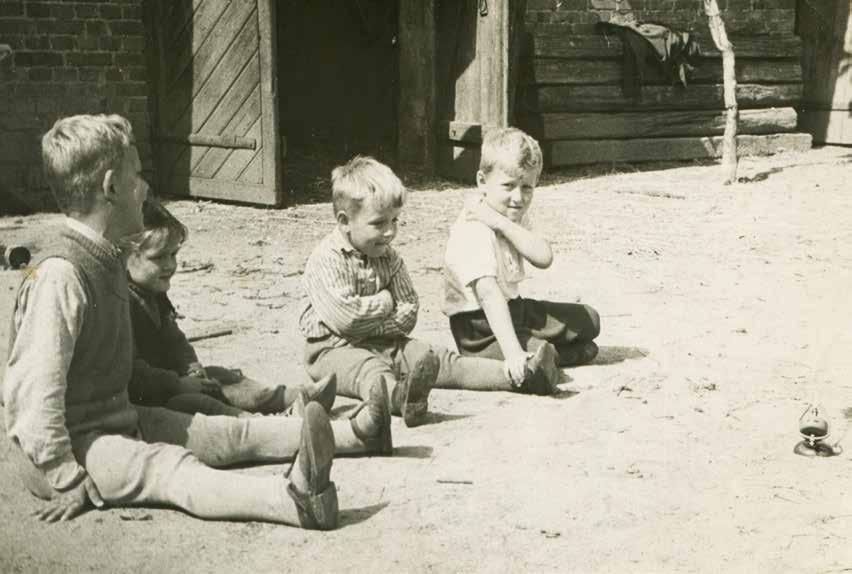
“Grandpa, this is so cool,” Otis breathed. “I can’t wait until tomorrow!”
Ed Swan coiled the hose up and placed it on the bed of the bright red 1965 International Harvester Model 1600 flat bed truck as his youngest grandson, Otis, danced around in excitement. On the bed of the truck, a shiny, 1500 gallon stainless steel water tank sat perched, now only filed to a third of capacity. The other 1000 gallons of water had just been emptied into a wooden dunk tank and now sat sparkling in the waning sunlight of the late July day. Ed and Otis were putting the finishing touches on one of the most sought-after attractions during one of the biggest celebrations in town…the dunk tank at Community Days.
The small farming hamlet sat nestled amongst rolling hills of fields and patches of uncut timber. Townsfolk had gotten together every year since 1908 to commemorate the town’s history. Seventy years later, the population of the town had changed, both in size and look. But one thing remained the same regardless of life’s ever-present change: Community Days was ALWAYS on the fourth Saturday of July. . Always. Never had it ever been held on any other day. The Swan family joked that it must be written down somewhere in the official city documents declaring it some sort of ordinance because it didn’t matter if the community members were farming or logging or working at other labors, that day held a special reverence. Taking a day off in the middle of harvest just wasn’t done and neither was closing down two blocks on Main Street…unless it was Community Days. Then both happened.
The Lion’s Club breakfast, the kiddie and main parades, trap and target shooting, logging competitions, game and food booths, and, of course, the dunk tank, always lined up on the agenda for the big day. Add in a little beer drinking and ‘shine sipping and the congregation tended to stay on the happy side. A local band, Flossie’s Fiddlers, along with DJ Rocky Starr, played danceable tunes appropriate for all ages. Without fail, a spectacular fireworks display smacked an exclamation point on the end of the day’s festivities.
Otis’s Grandpa Ed volunteered in 1965 to bring the then-new water truck into town to fill up the ever-present dunk tank. This was his twenty-third year handling the job. The tank served as a tremendous money-maker for the high school cheerleaders and football players. A dollar got you four baseballs to attempt hitting the metal bullseye attached to the arm under a seat perched over the water. Full contact would release the latch that held the seat in place, sending the victim splashing into the water. A glancing blow usually didn’t release the latch, so it took a bit of skill—and luck—to be victorious in drenching the dunk victim. One could also pay the “Dunk Police” to put someone on the seat. The only way to avoid the “sentence” was to pay the $5 bail, otherwise, you were condemned to take your seat above the watery abyss and sweat it out for the allotted 15 minutes.
The tank opened promptly after the parade and ran until the start of the dance. Within that stretch of six hours, the cheerleaders and football players brought in enough money to pay for new uniforms, pom poms, and travel expenses if they headed to State.
“We best be getting back home, Otis,” Ed said. “We’ve got an exciting day tomorrow.”
Otis climbed into the passenger seat of the big truck with a smile plastered on his face. For an eight-year-old kid, Community Days served up a whopping heap of fun. The butterflies danced in his tummy; he knew he wouldn’t be able to sleep.
The hot rod ran like a champ and the brakes held during the parade. As Otis started to drive it towards the designated parking spot next to his grandparents’ truck, three of his friends came running up to him. “Otis, can we have a ride to the park?”
“Sure,” Otis agreed without thinking. “Hop on!”
Just about the moment the kids piled onto the contraption, Otis’s mom, Mavis, came out of nowhere and walked swiftly up to the crew. “Otis, where are you going with your friends?” she demanded.
“Umm, well, I, uh,” he stammered, hearing his dad’s warning in his head. “I just wanted to give them a quick ride.”
“Nope,” Mavis stated. “You kids get off, Otis has to park the hot rod. He’ll come find you in a little bit.”
The kids jetted off to the park, and Otis drove the hot rod with Mavis chaperoning his trip to the pickup. He parked and as he jumped off, Mavis grabbed him by the arm.
“You can join your friends,” Mavis said, “but you better behave.” “I will,” Otis shouted over his shoulder, relieved his mom didn’t make him go with her for the day.
Feeling flush with cash, he joined his friends at the Bingo Booth and threw his $20 bill on the counter. “I’ll take two cards,” he boasted. Within ten minutes at fifty cents a card, he’d lost half his money. Discouraged, he asked his friends to move on to the food and games. He was careful to only spend a few dollars on food so he could try the dunk tank later. After feasting on hot dogs, all but one of his pals wandered off, his best friend, Cameron.
“What should we do, Cam?” Otis stretched and yawned. The heat of the day was almost suffocating. It was turning out to be a real scorcher.
“I have some firecrackers we could set off,” Cam suggested. “How do we do that and not get caught?” Otis was immediately ready for action.
“We toss ‘em in one of the garbage cans behind the Lion’s cook shack,” Cam slyly offered.
Otis was always ready for firecrackers. “OK!”
The next morning, Marvel Swan lined up his seven children— Otho, Deanie, Doris, Cletis, Chuck, Gladys, and Otis—in the kitchen and handed them each a crisp $20 bill. “This is to last you the entire day, so be wise with your spending,” he preached. “That includes fun AND food.”
The kids took their cash and filed out to the cars to head into town. “We’ll take the hot rod in for you to ride in the parade, Otis, but no running around after,” Marvel warned. “Park it next to the truck, and Grandpa will bring it home when he comes back later for the water truck. Understood?”
“Yes, sir,” Otis automatically replied.
“Alright everyone, let’s go have some fun!” Marvel, Mavis, and a few kids settled into the family car, loaded down with two coolers filled with drinks and snacks to last throughout the day in case the children didn’t heed the warning to spend the gifted money for some food. The remainder of the kids piled into Deanie and Otho’s ’65 Ford Falcon. Grandpa Ed and Grandma Helen sat in the pickup truck, loaded down with lawn chairs, blankets, and the hot rod for Otis to take through the parade. Ed had triple-checked the brakes the night before.
The boys raced to their destination, but stopped about twenty yards away from the cook shack so as not to draw attention. They moseyed along, inspecting all sides of their target from a distance, noticing only two people manning the shack.
“We gotta light ‘em and then run away fast,” Otis whispered. “Exactly,” Cam whispered back. “But it’s Mr. and Mrs. Pots, and they’re kind of hard of hearing.”
The two boys made a wide swath through the trees and ended up on the back side of the shack where the garbage cans stood. The cans were old 55-gallon metal oil drums, perfect for extra modulation of the pyrotechnics.
Cam put his hand on Otis’s shoulder, “I have a cherry bomb, too.”
Otis knew very well the explosive nature of cherry bombs.
“You’ll blow a hole in the can, I guarantee it,” he warned, but didn’t voice any objections.
The two imps lit the fuses of several fire crackers and the cherry bomb. The sizzle sound sent Otis and Cam scurrying. The can jumped about a foot off the ground as the cherry bomb blasted a six-inch hole through the can. Smaller pops from the firecrackers served as background noise to the cherry bomb’s intense ka-boom. Otis and Cam stood in the trees watching, hysterically laughing. The jocularity came to an abrupt end, however, when Otis’s dad, Marvel, came up behind them.
“Otis,” he said in a stern, but ominously quiet tone.
* * * * * *
Otis and Cam jumped and whirled around, immediately realizing their fate.
Otis looked his dad in the eye and truthfully offered, “Those were not my fireworks, Dad. I promise.”
Marvel knew there was a technicality in there somewhere. “You better go sit with your mom and Grandma Helen for a little while,” he ordered. “They’re watching the logging competitions.”
“Yes, sir,” Otis replied.
“I better go find my parents,” Cam blurted out as he started to scoot off.
“That’s an excellent idea, Cameron,” Marvel commented. Otis skedaddled to the part of the park where lumberjacks and jills competed for cash prizes.

“Dad told me I had to come sit with you,” he mumbled to Mavis and Grandma Helen.
Mavis knew Otis must be into mischief once again if he was sent by Marvel’s. She sighed, wondering how her youngest child always managed to cause shenanigans. “Do you want a drink, Otis?”
“Shasta root beer?” he asked.
“Sure, it’s in the cooler.”
Otis jumped up and opened the cooler sitting behind Mavis’s lawn chair. He spied a can of his favorite soda, grabbed it, and immediately cracked the top open. Root beer spewed out of the hole in fountain fashion, dousing the back of Mavis’s hair, neck, and shirt.
“Oh, Otis!” Mavis shrieked as she whirled around. “You didn’t have to shake it up!”
“I didn’t, Mom!” Otis defended.
“Now I’m a sticky mess,” Mavis lamented.
Grandma Helen reached into her purse and produced a wad of napkins. She grabbed their red plastic water jug, wet down the napkins, and started dabbing the sticky liquid off Mavis’s neck and hair. “Your shirt is another story,” she smirked.
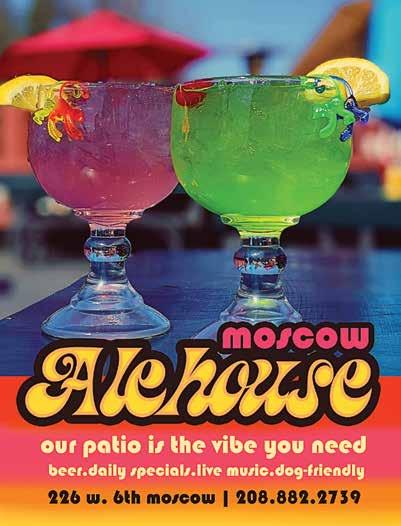
About that time Grandpa Ed showed up on the scene. He’d seen the disaster from a distance and came to offer an escape for Otis, who was clearly in hot water.
“Oh, Ed, thank goodness. Can you please take Otis?” she said through gritted teeth.
“Sure,” Ed put his burly hand on Otis’s shoulder. “I’d be happy to take this young lad on adventures unknown.”
“Please, for the love of Peter, no adventures,” Mavis pleaded. “Just take him to get his energy out.”
“Done,” Ed smiled. “We’ll load up the hot rod and take it back to the house and bring back the water truck to refill the dunk tank.”
“Can you grab me a shirt while you’re at the house?” Mavis begged.
They’d come into town the “back way.” If anyone saw them, they wouldn’t think anything about it since everyone knew Ed refilled the dunk tank at least once during the day.
Ed stopped the truck and hopped out, hollering at Otis to hop out, too. Otis complied, and Ed hoisted him up onto the bed of the truck next to the water tank. He then grabbed the hose and handed to Otis.
Otis’s slowly took the hose. “What are we doing, Grandpa?” he slowly asked.
“We’re gonna cool everyone down, then go fill up the dunk tank,” Ed replied matter-of-factly.
*
* *
“Grandpa!” Otis knew exactly the plan now. The thrill of doing something so naughty won out over any fear of trouble. He couldn’t get into that much dutch with Grandpa leading the charge.
The water truck set-up consisted of a 5-horsepower Briggs and Stratton motor on a Flowmax transfer pump, which had both a 2-inch inlet and outlet. For today’s purposes, however, Ed modified the outlet off the hose down to a 1.5-inch firehose, complete with an adjustable nozzle. It was designed to pump volume with only a slight kick to the stream. He didn’t want to hurt anyone, but envisioned Otis dousing everyone down on this hot day with only a few of them landing on their keisters. He’d checked the thermometer as they left the house with the truck. Ninety degrees. Heck, he was doing everyone a favor getting them wet. Save on heat stroke and such.
“Are you ready, kiddo?” he asked Otis.
“READY!” Otis shouted. He couldn’t believe his luck; he’d been in trouble with his parents all day, and now he was going to get to do THIS.
“Make sure not to hose any one specific person down too much, ok?” Ed instructed as he climbed into the cab of the truck.
“Got it!” Otis yelled.

Ed started up the engine and yelled, “Hang on!” Otis braced himself. As they rounded the corner of Main Street, Otis opened up the hose, taking the first few people he sprayed by surprise. Yelps and shrieks rippled through the crowd as Ed carefully made his way through the throngs of revelers. Otis stood centered on the truck bed so his vantage point allowed for full coverage at about 100 feet. For the most part, people laughed and welcomed the refreshing gift. Men covered their beers and stood to meet the stream of cool liquid. Some women hurried away so as to not get wet. A few ended up landing on their bums…but only a few. Kids started following behind the truck in Pied Piper fashion, begging Otis to spray them. “Again, Otis! Again!” Otis complied by blasting them, eliciting glee and delight, and only sending a few toddlers lurching backwards with the water blast.
As Ed pulled into the park area where the dunk tank sat, Otis shut off the valve so he didn’t drench the booths. Ed hopped out of the cab and rounded the corner of the back of the truck.
“Oh, Otis!” he whooped!
“Oh, Grandpa!” Otis laughed with unbridled abandon; his sides ached and tears streamed down his cheeks; he couldn’t stop the delight that pulsed through his body. “That was the best time I ever had!” He jumped off and hugged Grandpa Ed…his partner in crime.
Ed removed the firehose nozzle and tossed the end of the hose into the dunk tank, which sat so shallow there wasn’t anyone perched on the seat. He opened up the lever and the water flowed. After topping off the tank, the crowd cheered. Another dunk-ee climbed into position, and the balls started flying once again.
“Say, Otis,” Ed smirked as he screwed the firehose nozzle back onto the end of the hose. “There’s still about half a tank. Wanna make another pass up Main Street?”
Otis scrambled into position on the bed of the truck. “Let’s roll, Grandpa!”
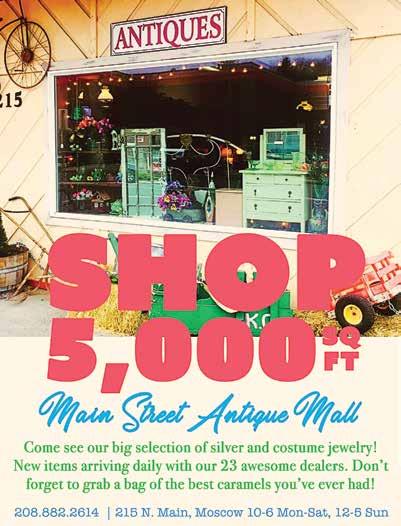
River Journal
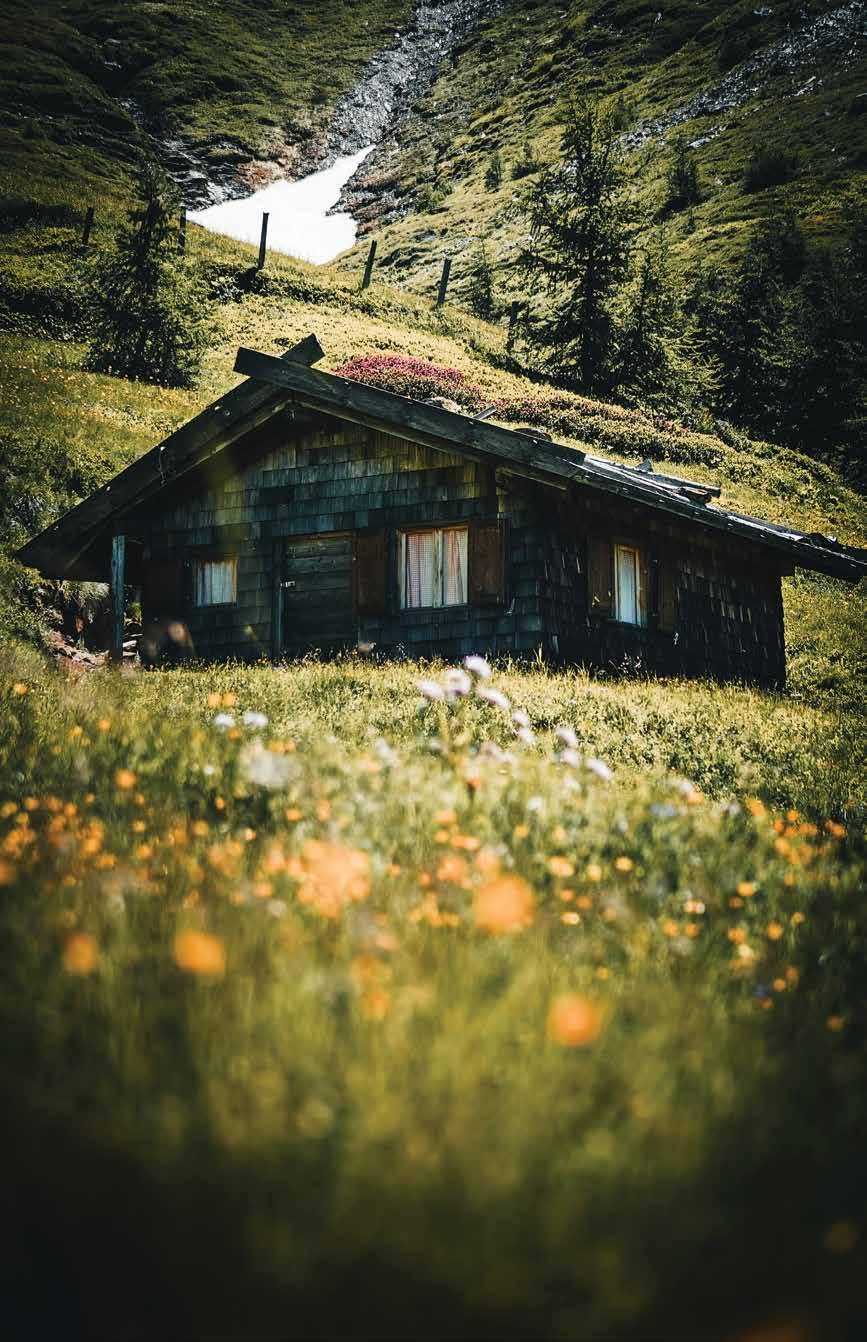
Jacqueline Cruver
Part 2
(If you are just joining my saga, the previous episode began with an image of a calm and friendly river, then in contrast, the result of melting snow and unabated rain. The cable that ferried us across the river to our homes had gone down and left two of us and a dog stranded. Leaving on foot for an alternate crossing made it clear we were not prepared for this scenario. Making it to safety, I continue the journal.)
1980
Wet and animated, we barged in on a friend in the nearest town down river. After listening to our dilemma, Rick agreed that hiking to town on the other side would have certainly been an even more difficult bushwhack. We hung our dripping coats and circled his wood stove. Offering us towels, our host informed us that several cabins had washed away across the river from his place. We knew ours was standing, but very much out of reach. The river dangled the keys.
The following day we donned our still-wet rain gear to go see how difficult it was going to be to gain entry. I had lost my voice from the trauma of the epic hike, so truly had no words upon arriving at the parking place. The flooding water had spared our landing but all that remained of the empty cabin that once sat forty feet from where we stood, were parts of its moss covered roof. Most of the hand-split cedar shakes had been carried off by the mad river, leaving small roof sections hanging there on the steep, newly exposed river-cut cliff. To direct the river to such an angle, we correctly surmised that further up river from us, uprooted trees had created a very large log jam at the last bend, altering the path as we slept. Looking down the river now was dizzying. The random piles of splintered lumber hung up in places along both banks suggested many cabins would be reported missing. There was no resemblance of the waterway with which we had become so familiar. We were disoriented. This was not home. As of now, we were simply somewhere else . . . and homeless.
The deadman anchor behind the landing seemed to be unmoved and the grand old rusty cable was firmly attached but descended straight down into the river and was secured to the bottom. Buried beneath tons of boulders never to be lifted from its resting place. Retreating to our temporary accommodations at Rick’s, we tried not to show each other any signs of surrender or despair. We waited weeks for the river to settle down, grateful that our host had plenty of room, and welcomed the company. In a book I selected from a dusty shelf to pass the hours, or perhaps it found me as books sometimes do, I found this quote:
“One has not only an ability to perceive the world but an ability to alter one’s perception of it; more simply, one can change things by the manner in which one looks at them.”
 Even
Even
Cowgirls Get The Blues, 1976 novel by Tom Robbins.
I cleaned my viewing glasses, blinked, and took another look. We were languishing and needed to wake up. We were wasting time. We got our balance and decided what our first step should be. We made calls and discussed possible options with everyone we knew with any engineering or logging knowledge. We needed to collect the necessary equipment to get going while the river became more congenial and the process of replacing the span with a temporary cable commenced. The work team of many river wading volunteers had the new anchor securely in place on our side of the river and the permanent cable up and running within a month.
Other repairs on our side of the river were not extensive, and with friends wanting to offer their help it went quickly. The high flow of rainfall had filled the gravity-fed cistern above the cabins with silt, but it was easily reconstructed. The system was a simple weir placed in the year round mountain stream that allowed sediment to settle and direct clean water over the top. A hose then carried water downhill to the garden area, to the bucket filling station for the cabins, and to the large claw foot tub at the edge of the meadow. A total of four trees had fallen, one on the roof covering the wood supply but with extra hands it was rebuilt and filled with the fallen trees that would be seasoned by next winter.
The dead branches gave me enough cookstove wood for several months. A large fallen branch had crushed one of the sides of the wire garden fence. Happy to volunteer, Margo offered to fix that to make up for weeding an entire row of parsley seedlings while helping with last year’s garden. Probably mistaking them for very uniform weeds. Margo was also the enthusiastic visitor who, grabbing a gun from the rack on Jim’s cabin wall, pulled the trigger to see if it was loaded, shooting a hole in his roof. This had happened earlier in the winter and the melting snow dripped from the hole onto his wood stove for a month until he could get on the roof to patch it. I heard she was a terrific skier, but we rarely left her unsupervised.
By the time spring weather dried into summer, a gathering to thank everyone for their help was arranged. A table was built in the upper meadow, and a fire pit dug. Food was abundant and canned beverages floated in the creek to stay chilled. Two pieces of plywood made a stage for a few musicians planning to come, placed as far from the noisy generator as possible and still be able to plug in the amplifiers. Anyone who wanted to could bring their tent for the weekend. At each car horn announcing a new arrival to the landing, the two experienced cable-car operators took turns bringing them across. There had been some serious injuries caused by operating the cable car with only confidence as credentials. We vowed to select only careful operators forevermore.
John and Pam came with a report of the progress on cutting a two story house in two and moving it over sixty miles down the highway and re-assembling it upon a hand dug basement. The house was free in exchange for removing it. John seemed capable of doing anything. He could rebuild cars, weld, upholster, carve stone and wood, fall trees, grow a huge garden, hunt and butcher game, can it, or cook it perfectly, and even made jewelry and laced lampshades. We all used him for his skills at one time or another, humbly available as our misfit tribe’s patriarch, and happy to trade his time for our goods or services. We could not have resurrected our homestead without him.

Greg and Diana arrived with more of their belongings in two trunks. They had spent the winter in a six by twelve foot shed until that had flooded in the high water so had set up a tent camp on our property. Their labor and availability were very appreciated. We liked being able to leave the property in their care when we travelled. Diana was a talented lead-glass artist and had made my kitchen cabinet doors depicting snow capped mountains with the river flowing beneath deep green forest branches. I traded her for my leather goods, a concho belt, and a fringed bag.
Our system of bartering had started in the early years of moving to the area. All of us had come to know each other through Jim when he had a small shop on the highway down the mountain. Jewelers, leathersmiths, potters, artists and eccentrics all had placed items in his shop and found cashless bartering to be the currency of choice. Prior to moving to the river property, I had traded leather goods for rent and house cleaning for fresh produce and eggs. With enough participants, a bartering community can very successfully balance what one person has too much of and another not enough. Best of all it relieved many financial burdens, replacing them with what time or talent you may proudly call your own. As a young woman on my own, I enjoyed this safe circle of friends, and was delighted to be offering our version of a potlatch to celebrate our connection and express our thanks to all of them. Word arrived with one of the many guests I did not know, that a few of the musicians would be arriving a bit later than planned. I dashed to the cabin to crank up the generator and play some albums for the opening music venue.










NMLS ID #527990 Make a splash in a new home this summer! Complete your mortgage application online in minutes at p1fcu.org . llAshtiafsfeilebera.emoclew
er’eydaer.pleh eWeragnikrowdrahpeekruoroineserac seitinummoc.efasruOmaetydaerrewsna ynasnoitseuquoyevahtuobagniognonoitacol ytilibaliavadnaytefas.snoituacerp llaC)802(0656-288nrael.erom
After following all the steps necessary for power to the turntable, I still had none. I followed the cords from the generator, up through the floor and into the small hole of the antique armoire I used as the music cabinet and all looked right. Pulling the turntable from its shelf, I found it to be not turning, and was squeaking. Well, more accurately the pink, hairless baby mice in a massive nest were squeaking. It was proof of the ability of a momma mouse to enter a hole about the size of a dime. Post eviction, the music commenced, soon to be replaced by the live performers lasting long into the night.
We made a new acquaintance soon after the gathering who shared an interesting account of his off the grid living up in Alaska. Bob had been working on the pipeline, and like many others had met the criteria of proving his six month residence to obtain a five acre homestead in the “bush ‘’ as it was called. We were always anxious to learn more about off grid living and accepted his invitation to travel back with him when he returned home. Many miles from Wasilla, we arrived at his parking spot and landing. At the head of a trail stood a small, locked cache to store tarps and straps for packing his supplies the two miles to his cabin. The trail was worn smooth into the permafrost which he explained was because he sometimes used a sled with slick runners even when there was no snow. He handed us bear bells from the cache to tie onto our belts and assured us bears would move away from approaching humans. It was an easy walk on mostly level ground winding through the sparse forest of small scale trees, and we soon spotted the small low profile log cabin adjacent to a full wood shed of equal dimensions. Bob’s dogs enthusiastically greeted him home and were promptly fed. The interior of the cabin was furnished with hand hewn built-ins including beds. Made completely of poles, his cache for non-perishable items was up a twenty foot ladder. In the kitchen was a hinged door that opened to a large hole dug into the permanently frozen ground. This was an advantage of his extreme conditions and beat our system of packing propane tanks for our refrigerator. His garden was shocking. The extended hours of daylight made XXL produce. He grew only crops suitable for canning. I put in a few moments tending weeds but surrendered to the bugs. It is also worth mentioning the mosquitos were so large they had smiles on their faces.

We spent the night, but the daylight glaring behind the thick room darkening curtains did not allow for much sleep. Daylight only surrendered to a short three hours of dusk and that was it. I lay awake staring at the US and world maps he had lining the ceiling above my bunk. I suppose to make it through extended stays there, one must allow the mind to travel to other realms during the long idle hours and maybe some company to remain grounded during the twenty hours of darkness in winter.
In the morning a friend arrived to run his dogs for him, which explained how he was able to do the amount of traveling he did. Neighbors were some distance away, but formed a cooperative to allow each other time away from the labor intensive lifestyle. We helped secure things for another extended departure and carried out empty packs for his next return with supplies. We had one more leg of this amazing Alaska excursion to go. Bob had arranged to take us to a homestead for sale farther north on the Susitna River. Climbing into his car, he insisted I take a front seat for the drive to Talkeetna.
In less than an hour’s drive the highway turned and the reason became clear. I gasped as the sight of Denali appeared straight ahead of us in a beautiful sunny blue sky backdrop. Rarely seen out of the constant cloud cover, there it was. It was heart-stoppingly-
-huge. The airfield at the end of the road was the destination and pickup point for all climbs executed on the majestic mountain. Bush planes equipped with skis for landing and operated only by experienced Alaska pilots deposited countless climbing parties to dangerous landing sites on the frightful mountain. We watched as a small, ratty plane with pontoons fitted over the landing tires taxied loudly and failed to lift off. Probably loaded for a remote high lake drop off, it stopped at the end of the runway and boxes were tossed off as the plane turned. It returned for another try and this time accelerated to a horribly harsh decibel and achieved lift off at the last moment, just brushing the tops of the perimeter trees. These pilots only knew white knuckled take-offs and even more frequent rough Alaska style landings. These were the true cowboys of the Alaska Range since before Alaska even achieved statehood.
That means of transportation was not for me. I was very happy we were going to be boarding the Alaska Railroad. The Denali Star was only scheduled to stop at the park entrance before continuing to Fairbanks but made stops at various mile post markers for the homesteaders. They just had to be sure to notify the engineer upon boarding, which Bob had done. The route was straight, making it easy to take in the view of the majestic mountain rising up out of the muskeg. We sensed the train slowing just as we began getting glimpses of the Susitna River. The whistle sounded to signal the train was stopped. We were allowed off the train at the milepost requested and the whistle sounded again to announce it was departing.

We moved away from the tracks toward a trail head marked by two signs. The letters had weathered off of one of them, leaving no clue to what it once said. I assumed it once displayed the name of the couple who had planned to put their hard work to the test and set up a working lifestyle in this remote spot but Bob explained that the previous owner had only come a few times to hunt and since he did not provide any receipts or records to prove his residency, had lost the title to the homestead. Subsistence hunting is available for bonafide residents for plenty of game for a family to survive if they have the skills. I tried to picture myself skinning a moose. The thought turned to possibly skinning a squirrel for meat and a hat and then just turned to walking into a nice big grocery store.
The other sign was larger and said “Corbet” in glossy yellow paint. This was the adjacent homestead that was owned by a couple that Bob was good friends with. On we walked, bear bells dinging, for the five mile hike to their cabin. We arrived and were introduced to the couple as potentially interested in the neighboring homestead. The couple greeted us with a wonderful meal of freshly butchered rabbit, salad and baked carrots and parsnips. The freshly baked sourdough bread was warm, and a gooseberry pie waited for dessert.
We toured the two greenhouses, the garden areas, and chicken house, goat hut and rabbit hutches, all with large storage cans for pellet food. The storage containers for staples were substantial and the cellar door in the kitchen floor revealed a much larger but divided space for perishables. They were very gracious hosts and we spent a long afternoon sharing our stories and theories in their comfortable, well built home. They admitted they were entertaining thoughts of finding a competent caretaker to manage their place for several years and return to the lower forty eight to spend time with family and pursue some self improvement skills. It would depend upon what legal issues were involved in such an arrangement so they would not lose the title to the land.

The Alaska homestead act had been granted a ten year extension in 1976 but there was speculation by the bush dwellers if the patents given for the parcels would remain secure.
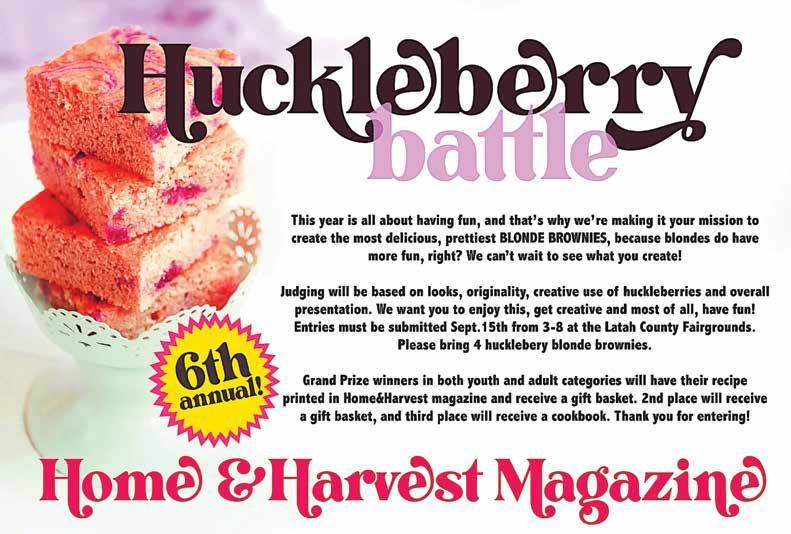
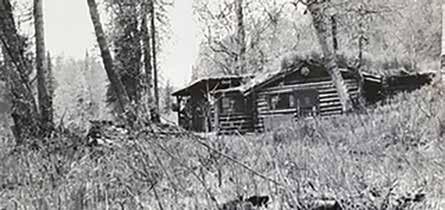
The hike back to the spot the train would hopefully stop for us, allowed time for questions and musings of the skills needed to succeed as a homesteader in the Alaskan bush. We carefully discussed and listed the items we would need to begin setting up the undeveloped acreage and prioritizing essential survival systems. The six month stay required to meet the criteria to gain ownership to a Susitna River homestead would not be that much of a challenge now that we already had built some structures. The river was not a component there. It was near enough to access but did not border the property. We could work all summer, then return to our present river cabins for the milder winter. After a few years of developing, there would be the option of remaining through an Alaskan winter. The experience of darkness and silence absorbed by many, many feet of snow. This was such an intriguing plan, our minds were spinning and we were constantly interrupting one another. I knew we would have the whole trip back to discuss it, but also knew the spirit of “Yes, let’s do it” was the common bond of these two partners. While our noble course hung in the clear Alaska air, I turned my thoughts to getting home and making a list for that grocery store.
 Photos, left: Jacqueline and her cabin.
Photos, left: Jacqueline and her cabin.


ICCU.COM/VisaRewards WE BELIEVE life should be rewarding. WE'VE GOT YOUR CASHBACK. WITH AN ICCU PREMIER REWARDS VISA CREDIT CARD Apply Today Start earning points and getting cash back for your everyday purchases. An Idaho Central Credit Union Premier Rewards Visa Credit Card comes packed with perks, including earning you 2 points per $1 spent. Apply today and earn 4,000 bonus points ($25 cash back) when you spend $500 per month for the rst 3 full months. Plus, get 0% interest for 6 months*. • 2 points per $1.00 spent on purchases, and 2x seasonal bonus point categories • No annual fee, no balance transfer fees, and no cash advance fees. • CardControl, Identity Theft Protection, and free card fraud monitoring • Travel perks and protection • 24/7 access with Mobile and Online Banking • And much more *Bonus point o er is only applicable for new consumer Premier Rewards Card accounts. New consumer Premier Rewards Card accounts earn 4,000 points. 4,000 points is equivalent to $25 cash back. Cash back redeemable at https://rewards.iccu.com/. Cash back paid as statement credit to cardholder. Cardholder(s) must spend an account aggregate of $500 every 30 days for the first 90 days from account opening to receive bonus points rewards. Bonus point earnings will be applied and eligibility will be calculated at the account level; not by card. Only new purchases and transactions posted with code CCP that earn points are eligible for rewards. Balance transfers do not qualify for points. Bonus points will be awarded once to each qualifying member account. Points will be posted during the first, full month following the promotion and 90-day spend period. New consumer Premier Rewards Card accounts will receive 0% interest for the first 6 months immediately following the opening of the account(s). Must sign up and have a new consumer Premier Rewards Card account to participate. O er not valid for ICCU business rewards cards, or members who currently hold a consumer ICCU Rewards or consumer Premier Rewards account. All loans OAC.
TREATING THE ENTIRE FAMILY LOCALLY
TRI-STATE EMERGENCY
If you are having an emergency, please dial 9-1-1 or go to the ER.
TRI-STATE FAMILY PRACTICE
Call to schedule an appointment with one of our three Family Practice clinics.
FAMILY PRACTICE & INTERNAL MEDICINE CLARKSTON

P: 509.758.1450
FAMILY PRACTICE LEWISTON
P: 208.848.9001
FAMILY PRACTICE CLEARWATER
P: 208.743.8416
TRI-STATE MINOR CARE
Available for patients with non-life threatening injuries or illnesses.
P: 509.769.2200
If you or a loved one would like to establish primary care and has not yet registered as a patient, please contact our New Patient Coordinator at 509.769.2014 or newpatients@tsmh.org. 1221
| TriStateHospital.org
P: 509.758.5511
Highland Avenue, Clarkston, WA






































 Photo, left: 1942, Lorang kids, Albert, Lois, Mae, friend Betty Scharnhorst and Rita Lorang in front.
Photo, above: 1944, School note by Mae Lorang
Photo, above: c.1945, Cousin Bud Jones with daughter Julia.
Photo, left: 1942, Lorang kids, Albert, Lois, Mae, friend Betty Scharnhorst and Rita Lorang in front.
Photo, above: 1944, School note by Mae Lorang
Photo, above: c.1945, Cousin Bud Jones with daughter Julia.






























 Cover Photo: LCHS Photo Brink.C.02: Carol Ryrie Brink as a young woman in the 1920s.
Photo, left: LCHS Photo Brink.C.21: University of Idaho May Queen procession, circa 1916. Carol Ryrie Brink is on the left, leading her pony Timmy.
Photo, right: LCHS Photo Brink.R.03: Wedding picture of Carol Ryrie and Raymond Brink, July 1918.
Cover Photo: LCHS Photo Brink.C.02: Carol Ryrie Brink as a young woman in the 1920s.
Photo, left: LCHS Photo Brink.C.21: University of Idaho May Queen procession, circa 1916. Carol Ryrie Brink is on the left, leading her pony Timmy.
Photo, right: LCHS Photo Brink.R.03: Wedding picture of Carol Ryrie and Raymond Brink, July 1918.





















 by Joe Evans
by Joe Evans

























 Photos, left: Jacqueline and her cabin.
Photos, left: Jacqueline and her cabin.


